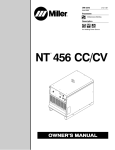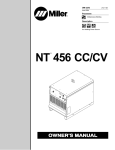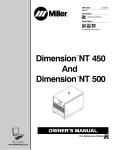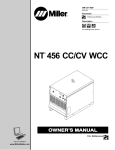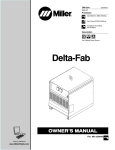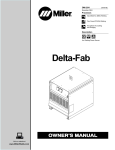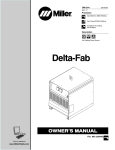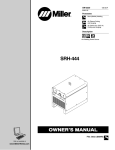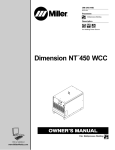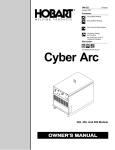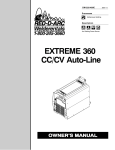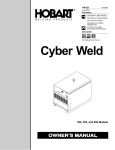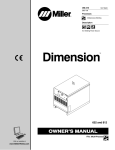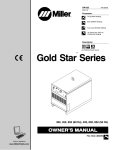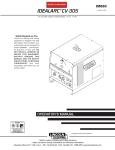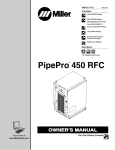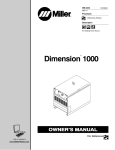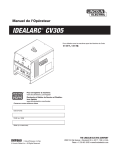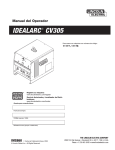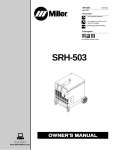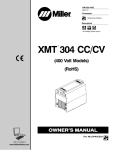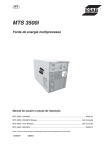Download Miller Electric NT 456 CC User's Manual
Transcript
OM-2243 212 113T 2007−10 Processes Multiprocess Welding Description Arc Welding Power Source NT 456 CC/CV File: Multiprocess Visit our website at www.MillerWelds.com From Miller to You Thank you and congratulations on choosing Miller. Now you can get the job done and get it done right. We know you don’t have time to do it any other way. That’s why when Niels Miller first started building arc welders in 1929, he made sure his products offered long-lasting value and superior quality. Like you, his customers couldn’t afford anything less. Miller products had to be more than the best they could be. They had to be the best you could buy. Today, the people that build and sell Miller products continue the tradition. They’re just as committed to providing equipment and service that meets the high standards of quality and value established in 1929. This Owner’s Manual is designed to help you get the most out of your Miller products. Please take time to read the Safety precautions. They will help you protect yourself against potential hazards on the worksite. We’ve made installation and operation quick and easy. With Miller you can count on years of reliable service with proper maintenance. And if for some reason the unit needs repair, there’s a Troubleshooting section that will help you figure out what the problem is. The Miller is the first welding parts list will then help you to decide the equipment manufacturer in exact part you may need to fix the problem. the U.S.A. to be registered to the ISO 9001:2000 Quality Warranty and service information for your System Standard. particular model are also provided. Miller Electric manufactures a full line of welders and welding related equipment. For information on other quality Miller products, contact your local Miller distributor to receive the latest full line catalog or individual specification sheets. To locate your nearest distributor or service agency call 1-800-4-A-Miller, or visit us at www.MillerWelds.com on the web. Mil_Thank 4/05 Working as hard as you do − every power source from Miller is backed by the most hassle-free warranty in the business. TABLE OF CONTENTS SECTION 1 − SAFETY PRECAUTIONS - READ BEFORE USING . . . . . . . . . . . . . . . . . . . . . . . . . . . . . . . . . . . 1-1. Symbol Usage . . . . . . . . . . . . . . . . . . . . . . . . . . . . . . . . . . . . . . . . . . . . . . . . . . . . . . . . . . . . . . . . . . . . . . . . 1-2. Arc Welding Hazards . . . . . . . . . . . . . . . . . . . . . . . . . . . . . . . . . . . . . . . . . . . . . . . . . . . . . . . . . . . . . . . . . . 1-3. Additional Symbols For Installation, Operation, And Maintenance . . . . . . . . . . . . . . . . . . . . . . . . . . . . . 1-4. California Proposition 65 Warnings . . . . . . . . . . . . . . . . . . . . . . . . . . . . . . . . . . . . . . . . . . . . . . . . . . . . . . . 1-5. Principal Safety Standards . . . . . . . . . . . . . . . . . . . . . . . . . . . . . . . . . . . . . . . . . . . . . . . . . . . . . . . . . . . . . 1-6. EMF Information . . . . . . . . . . . . . . . . . . . . . . . . . . . . . . . . . . . . . . . . . . . . . . . . . . . . . . . . . . . . . . . . . . . . . . SECTION 2 − CONSIGNES DE SÉCURITÉ − LIRE AVANT UTILISATION . . . . . . . . . . . . . . . . . . . . . . . . . . . . 2-1. Symboles utilisés . . . . . . . . . . . . . . . . . . . . . . . . . . . . . . . . . . . . . . . . . . . . . . . . . . . . . . . . . . . . . . . . . . . . . 2-2. Dangers relatifs au soudage à l’arc . . . . . . . . . . . . . . . . . . . . . . . . . . . . . . . . . . . . . . . . . . . . . . . . . . . . . . 2-3. Dangers supplémentaires en relation avec l’installation, le fonctionnement et la maintenance . . . . . . 2-4. Proposition californienne 65 Avertissements . . . . . . . . . . . . . . . . . . . . . . . . . . . . . . . . . . . . . . . . . . . . . . . 2-5. Principales normes de sécurité . . . . . . . . . . . . . . . . . . . . . . . . . . . . . . . . . . . . . . . . . . . . . . . . . . . . . . . . . . 2-6. Information EMF . . . . . . . . . . . . . . . . . . . . . . . . . . . . . . . . . . . . . . . . . . . . . . . . . . . . . . . . . . . . . . . . . . . . . . SECTION 3 − DEFINITIONS . . . . . . . . . . . . . . . . . . . . . . . . . . . . . . . . . . . . . . . . . . . . . . . . . . . . . . . . . . . . . . . . . . . 3-1. Nameplate Safety Symbols . . . . . . . . . . . . . . . . . . . . . . . . . . . . . . . . . . . . . . . . . . . . . . . . . . . . . . . . . . . . . SECTION 4 − INSTALLATION . . . . . . . . . . . . . . . . . . . . . . . . . . . . . . . . . . . . . . . . . . . . . . . . . . . . . . . . . . . . . . . . . . 4-1. Specifications . . . . . . . . . . . . . . . . . . . . . . . . . . . . . . . . . . . . . . . . . . . . . . . . . . . . . . . . . . . . . . . . . . . . . . . . 4-2. Duty Cycle And Overheating . . . . . . . . . . . . . . . . . . . . . . . . . . . . . . . . . . . . . . . . . . . . . . . . . . . . . . . . . . . . 4-3. Volt-Ampere Curves . . . . . . . . . . . . . . . . . . . . . . . . . . . . . . . . . . . . . . . . . . . . . . . . . . . . . . . . . . . . . . . . . . . 4-4. Selecting A Location . . . . . . . . . . . . . . . . . . . . . . . . . . . . . . . . . . . . . . . . . . . . . . . . . . . . . . . . . . . . . . . . . . . 4-5. Dimensions And Weights . . . . . . . . . . . . . . . . . . . . . . . . . . . . . . . . . . . . . . . . . . . . . . . . . . . . . . . . . . . . . . . 4-6. Tipping . . . . . . . . . . . . . . . . . . . . . . . . . . . . . . . . . . . . . . . . . . . . . . . . . . . . . . . . . . . . . . . . . . . . . . . . . . . . . . 4-7. 115 VAC Receptacle And Circuit Breakers . . . . . . . . . . . . . . . . . . . . . . . . . . . . . . . . . . . . . . . . . . . . . . . . 4-8. Weld Output Terminals And Selecting Cable Sizes . . . . . . . . . . . . . . . . . . . . . . . . . . . . . . . . . . . . . . . . . . 4-9. Connecting Weld Output Cables . . . . . . . . . . . . . . . . . . . . . . . . . . . . . . . . . . . . . . . . . . . . . . . . . . . . . . . . . 4-10. Remote 14 Receptacle Information . . . . . . . . . . . . . . . . . . . . . . . . . . . . . . . . . . . . . . . . . . . . . . . . . . . . . . . 4-11. Connecting Remote Control . . . . . . . . . . . . . . . . . . . . . . . . . . . . . . . . . . . . . . . . . . . . . . . . . . . . . . . . . . . . 4-12. Electrical Service Guide . . . . . . . . . . . . . . . . . . . . . . . . . . . . . . . . . . . . . . . . . . . . . . . . . . . . . . . . . . . . . . . . 4-13. Placing Jumper Links . . . . . . . . . . . . . . . . . . . . . . . . . . . . . . . . . . . . . . . . . . . . . . . . . . . . . . . . . . . . . . . . . . 4-14. Connecting Input Power . . . . . . . . . . . . . . . . . . . . . . . . . . . . . . . . . . . . . . . . . . . . . . . . . . . . . . . . . . . . . . . . SECTION 5 − OPERATION . . . . . . . . . . . . . . . . . . . . . . . . . . . . . . . . . . . . . . . . . . . . . . . . . . . . . . . . . . . . . . . . . . . . 5-1. Controls . . . . . . . . . . . . . . . . . . . . . . . . . . . . . . . . . . . . . . . . . . . . . . . . . . . . . . . . . . . . . . . . . . . . . . . . . . . . . 5-2. Meter Functions For CC/CV Models . . . . . . . . . . . . . . . . . . . . . . . . . . . . . . . . . . . . . . . . . . . . . . . . . . . . . . 5-3. Lift-Arc TIG Procedure For CC/CV Models . . . . . . . . . . . . . . . . . . . . . . . . . . . . . . . . . . . . . . . . . . . . . . . . SECTION 6 − MAINTENANCE & TROUBLESHOOTING . . . . . . . . . . . . . . . . . . . . . . . . . . . . . . . . . . . . . . . . . . . 6-1. Routine Maintenance . . . . . . . . . . . . . . . . . . . . . . . . . . . . . . . . . . . . . . . . . . . . . . . . . . . . . . . . . . . . . . . . . . 6-2. Fuse F1 . . . . . . . . . . . . . . . . . . . . . . . . . . . . . . . . . . . . . . . . . . . . . . . . . . . . . . . . . . . . . . . . . . . . . . . . . . . . . 6-3. Voltmeter/Ammeter Help Displays . . . . . . . . . . . . . . . . . . . . . . . . . . . . . . . . . . . . . . . . . . . . . . . . . . . . . . . 6-4. Troubleshooting . . . . . . . . . . . . . . . . . . . . . . . . . . . . . . . . . . . . . . . . . . . . . . . . . . . . . . . . . . . . . . . . . . . . . . SECTION 7 − ELECTRICAL DIAGRAM . . . . . . . . . . . . . . . . . . . . . . . . . . . . . . . . . . . . . . . . . . . . . . . . . . . . . . . . . . SECTION 8 − PARTS LIST . . . . . . . . . . . . . . . . . . . . . . . . . . . . . . . . . . . . . . . . . . . . . . . . . . . . . . . . . . . . . . . . . . . . . OPTIONS AND ACCESSORIES WARRANTY 1 1 1 3 4 4 4 5 5 5 7 8 9 9 11 11 12 12 12 13 14 15 16 16 17 17 18 18 19 19 20 21 21 22 23 24 24 24 25 26 27 28 Notes SECTION 1 − SAFETY PRECAUTIONS - READ BEFORE USING som _2007−04 7 Protect yourself and others from injury — read and follow these precautions. 1-1. Symbol Usage DANGER! − Indicates a hazardous situation which, if not avoided, will result in death or serious injury. The possible hazards are shown in the adjoining symbols or explained in the text. Indicates a hazardous situation which, if not avoided, could result in death or serious injury. The possible hazards are shown in the adjoining symbols or explained in the text. NOTICE − Indicates statements not related to personal injury. Indicates special instructions. This group of symbols means Warning! Watch Out! ELECTRIC SHOCK, MOVING PARTS, and HOT PARTS hazards. Consult symbols and related instructions below for necessary actions to avoid the hazards. 1-2. Arc Welding Hazards The symbols shown below are used throughout this manual to call attention to and identify possible hazards. When you see the symbol, watch out, and follow the related instructions to avoid the hazard. The safety information given below is only a summary of the more complete safety information found in the Safety Standards listed in Section 1-5. Read and follow all Safety Standards. Only qualified persons should install, operate, maintain, and repair this unit. During operation, keep everybody, especially children, away. Always verify the supply ground − check and be sure that input power cord ground wire is properly connected to ground terminal in disconnect box or that cord plug is connected to a properly grounded receptacle outlet. When making input connections, attach proper grounding conductor first − double-check connections. Keep cords dry, free of oil and grease, and protected from hot metal and sparks. Frequently inspect input power cord for damage or bare wiring − replace cord immediately if damaged − bare wiring can kill. Turn off all equipment when not in use. Do not use worn, damaged, undersized, or poorly spliced cables. Do not drape cables over your body. ELECTRIC SHOCK can kill. Touching live electrical parts can cause fatal shocks or severe burns. The electrode and work circuit is electrically live whenever the output is on. The input power circuit and machine internal circuits are also live when power is on. In semiautomatic or automatic wire welding, the wire, wire reel, drive roll housing, and all metal parts touching the welding wire are electrically live. Incorrectly installed or improperly grounded equipment is a hazard. Do not touch live electrical parts. Wear dry, hole-free insulating gloves and body protection. Insulate yourself from work and ground using dry insulating mats or covers big enough to prevent any physical contact with the work or ground. Do not use AC output in damp areas, if movement is confined, or if there is a danger of falling. Use AC output ONLY if required for the welding process. If AC output is required, use remote output control if present on unit. Additional safety precautions are required when any of the following electrically hazardous conditions are present: in damp locations or while wearing wet clothing; on metal structures such as floors, gratings, or scaffolds; when in cramped positions such as sitting, kneeling, or lying; or when there is a high risk of unavoidable or accidental contact with the workpiece or ground. For these conditions, use the following equipment in order presented: 1) a semiautomatic DC constant voltage (wire) welder, 2) a DC manual (stick) welder, or 3) an AC welder with reduced open-circuit voltage. In most situations, use of a DC, constant voltage wire welder is recommended. And, do not work alone! Disconnect input power or stop engine before installing or servicing this equipment. Lockout/tagout input power according to OSHA 29 CFR 1910.147 (see Safety Standards). Properly install and ground this equipment according to its Owner’s Manual and national, state, and local codes. If earth grounding of the workpiece is required, ground it directly with a separate cable. Do not touch electrode if you are in contact with the work, ground, or another electrode from a different machine. Do not touch electrode holders connected to two welding machines at the same time since double open-circuit voltage will be present. Use only well-maintained equipment. Repair or replace damaged parts at once. Maintain unit according to manual. Wear a safety harness if working above floor level. Keep all panels and covers securely in place. Clamp work cable with good metal-to-metal contact to workpiece or worktable as near the weld as practical. Insulate work clamp when not connected to workpiece to prevent contact with any metal object. Do not connect more than one electrode or work cable to any single weld output terminal. SIGNIFICANT DC VOLTAGE exists in inverter-type welding power sources after removal of input power. Turn Off inverter, disconnect input power, and discharge input capacitors according to instructions in Maintenance Section before touching any parts. HOT PARTS can cause severe burns. Do not touch hot parts bare handed. Allow cooling period before working on gun or torch. To handle hot parts, use proper tools and/or wear heavy, insulated welding gloves and clothing to prevent burns. OM-2243 Page 1 FUMES AND GASES can be hazardous. Welding produces fumes and gases. Breathing these fumes and gases can be hazardous to your health. Keep your head out of the fumes. Do not breathe the fumes. If inside, ventilate the area and/or use local forced ventilation at the arc to remove welding fumes and gases. If ventilation is poor, wear an approved air-supplied respirator. Read and understand the Material Safety Data Sheets (MSDSs) and the manufacturer’s instructions for metals, consumables, coatings, cleaners, and degreasers. Work in a confined space only if it is well ventilated, or while wearing an air-supplied respirator. Always have a trained watchperson nearby. Welding fumes and gases can displace air and lower the oxygen level causing injury or death. Be sure the breathing air is safe. Do not weld in locations near degreasing, cleaning, or spraying operations. The heat and rays of the arc can react with vapors to form highly toxic and irritating gases. Do not weld on coated metals, such as galvanized, lead, or cadmium plated steel, unless the coating is removed from the weld area, the area is well ventilated, and while wearing an air-supplied respirator. The coatings and any metals containing these elements can give off toxic fumes if welded. ARC RAYS can burn eyes and skin. Arc rays from the welding process produce intense visible and invisible (ultraviolet and infrared) rays that can burn eyes and skin. Sparks fly off from the weld. Wear an approved welding helmet fitted with a proper shade of filter lenses to protect your face and eyes when welding or watching (see ANSI Z49.1 and Z87.1 listed in Safety Standards). Wear approved safety glasses with side shields under your helmet. Do not use welder to thaw frozen pipes. Remove stick electrode from holder or cut off welding wire at contact tip when not in use. Wear oil-free protective garments such as leather gloves, heavy shirt, cuffless trousers, high shoes, and a cap. Remove any combustibles, such as a butane lighter or matches, from your person before doing any welding. After completion of work, inspect area to ensure it is free of sparks, glowing embers, and flames. Use only correct fuses or circuit breakers. Do not oversize or bypass them. Follow requirements in OSHA 1910.252 (a) (2) (iv) and NFPA 51B for hot work and have a fire watcher and extinguisher nearby. FLYING METAL or DIRT can injure eyes. Welding, chipping, wire brushing, and grinding cause sparks and flying metal. As welds cool, they can throw off slag. Wear approved safety glasses with side shields even under your welding helmet. BUILDUP OF GAS can injure or kill. Shut off shielding gas supply when not in use. Always ventilate confined spaces or use approved air-supplied respirator. MAGNETIC FIELDS can affect Implanted Medical Devices. Wearers of Pacemakers and other Implanted Medical Devices should keep away. Implanted Medical Device wearers should consult their doctor and the device manufacturer before going near arc welding, spot welding, gouging, plasma arc cutting, or induction heating operations. Use protective screens or barriers to protect others from flash, glare and sparks; warn others not to watch the arc. NOISE can damage hearing. Wear protective clothing made from durable, flame-resistant material (leather, heavy cotton, or wool) and foot protection. Noise from some processes or equipment can damage hearing. WELDING can cause fire or explosion. Welding on closed containers, such as tanks, drums, or pipes, can cause them to blow up. Sparks can fly off from the welding arc. The flying sparks, hot workpiece, and hot equipment can cause fires and burns. Accidental contact of electrode to metal objects can cause sparks, explosion, overheating, or fire. Check and be sure the area is safe before doing any welding. Remove all flammables within 35 ft (10.7 m) of the welding arc. If this is not possible, tightly cover them with approved covers. Do not weld where flying sparks can strike flammable material. Protect yourself and others from flying sparks and hot metal. Be alert that welding sparks and hot materials from welding can easily go through small cracks and openings to adjacent areas. Watch for fire, and keep a fire extinguisher nearby. Be aware that welding on a ceiling, floor, bulkhead, or partition can cause fire on the hidden side. Do not weld on closed containers such as tanks, drums, or pipes, unless they are properly prepared according to AWS F4.1 (see Safety Standards). Do not weld where the atmosphere may contain flammable dust, gas, or liquid vapors (such as gasoline). Connect work cable to the work as close to the welding area as practical to prevent welding current from traveling long, possibly unknown paths and causing electric shock, sparks, and fire hazards. OM-2243 Page 2 Wear approved ear protection if noise level is high. CYLINDERS can explode if damaged. Shielding gas cylinders contain gas under high pressure. If damaged, a cylinder can explode. Since gas cylinders are normally part of the welding process, be sure to treat them carefully. Protect compressed gas cylinders from excessive heat, mechanical shocks, physical damage, slag, open flames, sparks, and arcs. Install cylinders in an upright position by securing to a stationary support or cylinder rack to prevent falling or tipping. Keep cylinders away from any welding or other electrical circuits. Never drape a welding torch over a gas cylinder. Never allow a welding electrode to touch any cylinder. Never weld on a pressurized cylinder − explosion will result. Use only correct shielding gas cylinders, regulators, hoses, and fittings designed for the specific application; maintain them and associated parts in good condition. Turn face away from valve outlet when opening cylinder valve. Keep protective cap in place over valve except when cylinder is in use or connected for use. Use the right equipment, correct procedures, and sufficient number of persons to lift and move cylinders. Read and follow instructions on compressed gas cylinders, associated equipment, and Compressed Gas Association (CGA) publication P-1 listed in Safety Standards. 1-3. Additional Symbols For Installation, Operation, And Maintenance FIRE OR EXPLOSION hazard. Do not install or place unit on, over, or near combustible surfaces. Do not install unit near flammables. Do not overload building wiring − be sure power supply system is properly sized, rated, and protected to handle this unit. FALLING UNIT can cause injury. MOVING PARTS can cause injury. Keep away from moving parts such as fans. Keep all doors, panels, covers, and guards closed and securely in place. Have only qualified persons remove doors, panels, covers, or guards for maintenance as necessary. Reinstall doors, panels, covers, or guards when maintenance is finished and before reconnecting input power. Use lifting eye to lift unit only, NOT running gear, gas cylinders, or any other accessories. Use equipment of adequate capacity to lift and support unit. If using lift forks to move unit, be sure forks are long enough to extend beyond opposite side of unit. READ INSTRUCTIONS. Read Owner’s Manual before using or servicing unit. Use only genuine replacement parts from the manufacturer. OVERUSE can cause OVERHEATING H.F. RADIATION can cause interference. Allow cooling period; follow rated duty cycle. Reduce current or reduce duty cycle before starting to weld again. Do not block or filter airflow to unit. FLYING SPARKS can cause injury. Wear a face shield to protect eyes and face. Shape tungsten electrode only on grinder with proper guards in a safe location wearing proper face, hand, and body protection. Sparks can cause fires — keep flammables away. STATIC (ESD) can damage PC boards. Put on grounded wrist strap BEFORE handling boards or parts. Use proper static-proof bags and boxes to store, move, or ship PC boards. ARC WELDING can cause interference. MOVING PARTS can cause injury. Keep away from moving parts. Keep away from pinch points such as drive rolls. WELDING WIRE can cause injury. Do not press gun trigger until instructed to do so. Do not point gun toward any part of the body, other people, or any metal when threading welding wire. High-frequency (H.F.) can interfere with radio navigation, safety services, computers, and communications equipment. Have only qualified persons familiar with electronic equipment perform this installation. The user is responsible for having a qualified electrician promptly correct any interference problem resulting from the installation. If notified by the FCC about interference, stop using the equipment at once. Have the installation regularly checked and maintained. Keep high-frequency source doors and panels tightly shut, keep spark gaps at correct setting, and use grounding and shielding to minimize the possibility of interference. Electromagnetic energy can interfere with sensitive electronic equipment such as computers and computer-driven equipment such as robots. Be sure all equipment in the welding area is electromagnetically compatible. To reduce possible interference, keep weld cables as short as possible, close together, and down low, such as on the floor. Locate welding operation 100 meters from any sensitive electronic equipment. Be sure this welding machine is installed and grounded according to this manual. If interference still occurs, the user must take extra measures such as moving the welding machine, using shielded cables, using line filters, or shielding the work area. OM-2243 Page 3 1-4. California Proposition 65 Warnings Welding or cutting equipment produces fumes or gases which contain chemicals known to the State of California to cause birth defects and, in some cases, cancer. (California Health & Safety Code Section 25249.5 et seq.) Battery posts, terminals and related accessories contain lead and lead compounds, chemicals known to the State of California to cause cancer and birth defects or other reproductive harm. Wash hands after handling. For Gasoline Engines: Engine exhaust contains chemicals known to the State of California to cause cancer, birth defects, or other reproductive harm. For Diesel Engines: Diesel engine exhaust and some of its constituents are known to the State of California to cause cancer, birth defects, and other reproductive harm. 1-5. Principal Safety Standards Safety in Welding, Cutting, and Allied Processes, ANSI Standard Z49.1, from Global Engineering Documents (phone: 1-877-413-5184, website: www.global.ihs.com). Recommended Safe Practices for the Preparation for Welding and Cutting of Containers and Piping, American Welding Society Standard AWS F4.1, from Global Engineering Documents (phone: 1-877-413-5184, website: www.global.ihs.com). National Electrical Code, NFPA Standard 70, from National Fire Protection Association, P.O. Box 9101, Quincy, MA 02269-9101 (phone: 617-770-3000, website: www.nfpa.org and www. sparky.org). Safe Handling of Compressed Gases in Cylinders, CGA Pamphlet P-1, from Compressed Gas Association, 4221 Walney Road, 5th Floor, Chantilly, VA 20151 (phone: 703-788-2700, website:www.cganet.com). Code for Safety in Welding and Cutting, CSA Standard W117.2, from Canadian Standards Association, Standards Sales, 5060 Mississauga, Ontario, Canada L4W 5NS (phone: 800-463-6727 or in Toronto 416-747-4044, website: www.csa-international.org). Safe Practice For Occupational And Educational Eye And Face Protection, ANSI Standard Z87.1, from American National Standards Institute, 25 West 43rd Street, New York, NY 10036–8002 (phone: 212-642-4900, website: www.ansi.org). Standard for Fire Prevention During Welding, Cutting, and Other Hot Work, NFPA Standard 51B, from National Fire Protection Association, P.O. Box 9101, Quincy, MA 02269-9101 (phone: 617-770-3000, website: www.nfpa.org. OSHA, Occupational Safety and Health Standards for General Industry, Title 29, Code of Federal Regulations (CFR), Part 1910, Subpart Q, and Part 1926, Subpart J, from U.S. Government Printing Office, Superintendent of Documents, P.O. Box 371954, Pittsburgh, PA 15250-7954 (phone: 1-866-512-1800) (there are 10 Regional Offices—phone for Region 5, Chicago, is 312-353-2220, website: www.osha.gov). 1-6. EMF Information Considerations About Welding And The Effects Of Low Frequency Electric And Magnetic Fields 1. Keep cables close together by twisting or taping them, or using a cable cover. Welding current, as it flows through welding cables, will cause electromagnetic fields. There has been and still is some concern about such fields. However, after examining more than 500 studies spanning 17 years of research, a special blue ribbon committee of the National Research Council concluded that: “The body of evidence, in the committee’s judgment, has not demonstrated that exposure to powerfrequency electric and magnetic fields is a human-health hazard.” However, studies are still going forth and evidence continues to be examined. Until the final conclusions of the research are reached, you may wish to minimize your exposure to electromagnetic fields when welding or cutting. 2. Arrange cables to one side and away from the operator. To reduce magnetic fields in the workplace, use the following procedures: OM-2243 Page 4 3. Do not coil or drape cables around your body. 4. Keep welding power source and cables as far away from operator as practical. 5. Connect work clamp to workpiece as close to the weld as possible. About Implanted Medical Devices: Implanted Medical Device wearers should consult their doctor and the device manufacturer before performing or going near arc welding, spot welding, gouging, plasma arc cutting, or induction heating operations. If cleared by your doctor, then following the above procedures is recommended. SECTION 2 − CONSIGNES DE SÉCURITÉ − LIRE AVANT UTILISATION fre_som_2007−04 7 Se protéger et protéger les autres contre le risque de blessure — lire et respecter ces consignes. 2-1. Symboles utilisés DANGER! − Indique une situation dangereuse qui si on l’évite pas peut donner la mort ou des blessures graves. Les dangers possibles sont montrés par les symboles joints ou sont expliqués dans le texte. Indique une situation dangereuse qui si on l’évite pas peut donner la mort ou des blessures graves. Les dangers possibles sont montrés par les symboles joints ou sont expliqués dans le texte. NOTE − Indique des déclarations pas en relation avec des blessures personnelles. Indique des instructions spécifiques. Ce groupe de symboles veut dire Avertissement! Attention! DANGER DE CHOC ELECTRIQUE, PIECES EN MOUVEMENT, et PIECES CHAUDES. Consulter les symboles et les instructions ci-dessous y afférant pour les actions nécessaires afin d’éviter le danger. 2-2. Dangers relatifs au soudage à l’arc Les symboles représentés ci-dessous sont utilisés dans ce manuel pour attirer l’attention et identifier les dangers possibles. En présence de l’un de ces symboles, prendre garde et suivre les instructions afférentes pour éviter tout risque. Les instructions en matière de sécurité indiquées ci-dessous ne constituent qu’un sommaire des instructions de sécurité plus complètes fournies dans les normes de sécurité énumérées dans la Section 2-5. Lire et observer toutes les normes de sécurité. Seul un personnel qualifié est autorisé à installer, faire fonctionner, entretenir et réparer cet appareil. Pendant le fonctionnement, maintenir à distance toutes les personnes, notamment les enfants de l’appareil. UNE DÉCHARGE ÉLECTRIQUE peut entraîner la mort. Le contact d’organes électriques sous tension peut provoquer des accidents mortels ou des brûlures graves. Le circuit de l’électrode et de la pièce est sous tension lorsque le courant est délivré à la sortie. Le circuit d’alimentation et les circuits internes de la machine sont également sous tension lorsque l’alimentation est sur Marche. Dans le mode de soudage avec du fil, le fil, le dérouleur, le bloc de commande du rouleau et toutes les parties métalliques en contact avec le fil sont sous tension électrique. Un équipement installé ou mis à la terre de manière incorrecte ou impropre constitue un danger. (à fil), 2) un poste à souder DC manuel (électrode) ou 3) un poste à souder AC à tension à vide réduite. Dans la plupart des situations, l’utilisation d’un poste à souder DC à fil à tension constante est recommandée. En outre, ne pas travailler seul ! Couper l’alimentation ou arrêter le moteur avant de procéder à l’installation, à la réparation ou à l’entretien de l’appareil. Déverrouiller l’alimentation selon la norme OSHA 29 CFR 1910.147 (voir normes de sécurité). Installer le poste correctement et le mettre à la terre convenablement selon les consignes du manuel de l’opérateur et les normes nationales, provinciales et locales. Toujours vérifier la terre du cordon d’alimentation. Vérifier et s’assurer que le fil de terre du cordon d’alimentation est bien raccordé à la borne de terre du sectionneur ou que la fiche du cordon est raccordée à une prise correctement mise à la terre. En effectuant les raccordements d’entrée, fixer d’abord le conducteur de mise à la terre approprié et contre-vérifier les connexions. Les câbles doivent être exempts d’humidité, d’huile et de graisse; protégez−les contre les étincelles et les pièces métalliques chaudes. Vérifier fréquemment le cordon d’alimentation afin de s’assurer qu’il n’est pas altéré ou à nu, le remplacer immédiatement s’il l’est. Un fil à nu peut entraîner la mort. Ne pas toucher aux pièces électriques sous tension. L’équipement doit être hors tension lorsqu’il n’est pas utilisé. Ne pas utiliser des câbles usés, endommagés, de grosseur insuffisante ou mal épissés. Ne pas enrouler les câbles autour du corps. Porter des gants isolants et des vêtements de protection secs et sans trous. Si la pièce soudée doit être mise à la terre, le faire directement avec un câble distinct. S’isoler de la pièce à couper et du sol en utilisant des housses ou des tapis assez grands afin d’éviter tout contact physique avec la pièce à couper ou le sol. Ne pas toucher l’électrode quand on est en contact avec la pièce, la terre ou une électrode provenant d’une autre machine. Ne pas se servir de source électrique à courant électrique dans les zones humides, dans les endroits confinés ou là où on risque de tomber. Se servir d’une source électrique à courant électrique UNIQUEMENT si le procédé de soudage le demande. Si l’utilisation d’une source électrique à courant électrique s’avère nécessaire, se servir de la fonction de télécommande si l’appareil en est équipé. D’autres consignes de sécurité sont nécessaires dans les conditions suivantes : risques électriques dans un environnement humide ou si l’on porte des vêtements mouillés ; sur des structures métalliques telles que sols, grilles ou échafaudages ; en position coincée comme assise, à genoux ou couchée ; ou s’il y a un risque élevé de contact inévitable ou accidentel avec la pièce à souder ou le sol. Dans ces conditions, utiliser les équipements suivants, dans l’ordre indiqué : 1) un poste à souder DC à tension constante Ne pas toucher des porte électrodes connectés à deux machines en même temps à cause de la présence d’une tension à vide doublée. N’utiliser qu’un matériel en bon état. Réparer ou remplacer sur-lechamp les pièces endommagées. Entretenir l’appareil conformément à ce manuel. Porter un harnais de sécurité si l’on doit travailler au-dessus du sol. S’assurer que tous les panneaux et couvercles sont correctement en place. Fixer le câble de retour de façon à obtenir un bon contact métalmétal avec la pièce à souder ou la table de travail, le plus près possible de la soudure. Isoler la pince de masse quand pas mis à la pièce pour éviter le contact avec tout objet métallique. Ne pas raccorder plus d’une électrode ou plus d’un câble de masse à une même borne de sortie de soudage. OM-2243 Page 5 Il reste une TENSION DC NON NÉGLIGEABLE dans les sources de soudage onduleur quand on a coupé l’alimentation. Arrêter les convertisseurs, débrancher le courant électrique et décharger les condensateurs d’alimentation selon les instructions indiquées dans la partie Entretien avant de toucher les pièces. DES PIÈCES CHAUDES peuvent provoquer des brûlures graves. Ne pas toucher à mains nues les parties chaudes. Prévoir une période de refroidissement avant de travailler à l’équipement. Ne pas toucher aux pièces chaudes, utiliser les outils recommandés et porter des gants de soudage et des vêtements épais pour éviter les brûlures. LE SOUDAGE peut provoquer un in cendie ou une explosion. Le soudage effectué sur des conteneurs fermés tel que des réservoirs, tambours ou des conduites peu provoquer leur éclatement. Des étincelles peuven être projetées de l’arc de soudure. La projection d’étincelles, des pièce chaudes et des équipements chauds peut provoquer des incendies e des brûlures. Le contact accidentel de l’électrode avec des objet métalliques peut provoquer des étincelles, une explosion, un surchauf fement ou un incendie. Avant de commencer le soudage, vérifier e s’assurer que l’endroit ne présente pas de danger. Déplacer toutes les substances inflammables à une distance de 10,7 m de l’arc de soudage. En cas d’impossibilité les recouvrir soigneusement avec des protections homologués. Ne pas souder dans un endroit là où des étincelles peuvent tomber sur des substances inflammables. LES FUMÉES ET LES GAZ peuvent être dangereux. Se protéger et d’autres personnes de la projection d’étincelles et de métal chaud. Le soudage génère des fumées et des gaz. Leur inhalation peut être dangereux pour votre santé. Des étincelles et des matériaux chauds du soudage peuvent facilement passer dans d’autres zones en traversant de petites fissures et des ouvertures. Eloigner votre tête des fumées. Ne pas respirer les fumées. Surveiller tout déclenchement d’incendie et tenir un extincteur à proximité. À l’intérieur, ventiler la zone et/ou utiliser une ventilation forcée au niveau de l’arc pour l’évacuation des fumées et des gaz de soudage. Le soudage effectué sur un plafond, plancher, paroi ou séparation peut déclencher un incendie de l’autre côté. Si la ventilation est médiocre, porter un respirateur anti-vapeurs approuvé. Ne pas effectuer le soudage sur des conteneurs fermés tels que des réservoirs, tambours, ou conduites, à moins qu’ils n’aient été préparés correctement conformément à AWS F4.1 (voir les normes de sécurité). Lire et comprendre les spécifications de sécurité des matériaux (MSDS) et les instructions du fabricant concernant les métaux, les consommables, les revêtements, les nettoyants et les dégraisseurs. Ne soudez pas si l’air ambiant est chargé de particules, gaz, ou vapeurs inflammables (vapeur d’essence, par exemple). Travailler dans un espace fermé seulement s’il est bien ventilé ou en portant un respirateur à alimentation d’air. Demander toujours à un surveillant dûment formé de se tenir à proximité. Des fumées et des gaz de soudage peuvent déplacer l’air et abaisser le niveau d’oxygène provoquant des blessures ou des accidents mortels. S’assurer que l’air de respiration ne présente aucun danger. Brancher le câble de masse sur la pièce le plus près possible de la zone de soudage pour éviter le transport du courant sur une longue distance par des chemins inconnus éventuels en provoquant des risques d’électrocution, d’étincelles et d’incendie. Ne pas souder dans des endroits situés à proximité d’opérations de dégraissage, de nettoyage ou de pulvérisation. La chaleur et les rayons de l’arc peuvent réagir en présence de vapeurs et former des gaz hautement toxiques et irritants. En cas de non utilisation, enlever la baguette d’électrode du porteélectrode ou couper le fil à la pointe de contact. Ne pas souder des métaux munis d’un revêtement, tels que l’acier galvanisé, plaqué en plomb ou au cadmium à moins que le revêtement n’ait été enlevé dans la zone de soudure, que l’endroit soit bien ventilé, et en portant un respirateur à alimentation d’air. Les revêtements et tous les métaux renfermant ces éléments peuvent dégager des fumées toxiques en cas de soudage. LES RAYONS DE L’ARC peuvent pro voquer des brûlures dans les yeux e sur la peau. Le rayonnement de l’arc du procédé de soudage génère des rayons visibles et invisibles intense (ultraviolets et infrarouges) susceptibles de provoquer des brûlure dans les yeux et sur la peau. Des étincelles sont projetées pendant le soudage. Porter un casque de soudage approuvé muni de verres filtrants approprié pour protéger visage et yeux pendant le soudage (voir ANSI Z49.1 et Z87.1 énuméré dans les normes de sécurité). Porter des lunettes de sécurité avec écrans latéraux même sous votre casque. Avoir recours à des écrans protecteurs ou à des rideaux pour protéger les autres contre les rayonnements les éblouissements et les étincelles ; prévenir toute personne sur les lieux de ne pas regarder l’arc. Porter des vêtements confectionnés avec des matières résistantes et ignifuges (cuir, coton lourd ou laine) et des bottes de protection. OM-2243 Page 6 Ne pas utiliser le poste de soudage pour dégeler des conduites gelées. Porter des vêtements de protection dépourvus d’huile tels que des gants en cuir, une chemise en matériau lourd, des pantalons sans revers, des chaussures hautes et un couvre chef. Avant de souder, retirer toute substance combustible de vos poches telles qu’un allumeur au butane ou des allumettes. Une fois le travail achevé, assurez−vous qu’il ne reste aucune trace d’étincelles incandescentes ni de flammes. Utiliser exclusivement des fusibles ou coupe−circuits appropriés. Ne pas augmenter leur puissance; ne pas les ponter. Une fois le travail achevé, assurez−vous qu’il ne reste aucune trace d’étincelles incandescentes ni de flammes. Utiliser exclusivement des fusibles ou coupe−circuits appropriés. Ne pas augmenter leur puissance; ne pas les ponter. Suivre les recommandations dans OSHA 1910.252(a)(2)(iv) et NFPA 51B pour les travaux à chaud et avoir de la surveillance et un extincteur à proximité. DES PIECES DE METAL ou DES SALETES peuvent provoquer des blessures dans les yeux. Le soudage, l’écaillement, le passage de la pièce à la brosse en fil de fer, et le meulage génèrent des étincelles et des particules métalliques volantes. Pendant la période de refroidissement des soudures, elles risquent de projeter du laitier. Porter des lunettes de sécurité avec écrans latéraux ou un écran facial. LES ACCUMULATIONS DE GAZ risquent de provoquer des blessures ou même la mort. Protéger les bouteilles de gaz comprimé d’une chaleur excessive, des chocs mécaniques, des dommages physiques, du laitier, des flammes ouvertes, des étincelles et des arcs. Fermer l’alimentation du gaz protecteur en cas de non-utilisation. Veiller toujours à bien aérer les espaces confinés ou se servir d’un respirateur d’adduction d’air homologué. Placer les bouteilles debout en les fixant dans un support stationnaire ou dans un porte-bouteilles pour les empêcher de tomber ou de se renverser. LES CHAMPS MAGNETIQUES peuvent affecter des implants médicaux. Porteur de simulateur cardiaque ou autre implants médicaux, rester à distance. Les porteurs d’implants doivent d’abord consulter leur médecin avant de s’approcher des opérations de soudage à l’arc, de soudage par points, de gougeage, du coupage plasma ou de chauffage par induction. Tenir les bouteilles éloignées des circuits de soudage ou autres circuits électriques. Ne jamais placer une torche de soudage sur une bouteille à gaz. Une électrode de soudage ne doit jamais entrer en contact avec une bouteille. Ne jamais souder une bouteille pressurisée − risque d’explosion. LE BRUIT peut endommager l’ouïe. Utiliser seulement des bouteilles de gaz protecteur, régulateurs, tuyaux et raccords convenables pour cette application spécifique ; les maintenir ainsi que les éléments associés en bon état. Le bruit des processus et des équipements peut affecter l’ouïe. Détourner votre visage du détendeur-régulateur lorsque vous ouvrez la soupape de la bouteille. Porter des protections approuvées pour les oreilles si le niveau sonore est trop élevé. Le couvercle du détendeur doit toujours être en place, sauf lorsque la bouteille est utilisée ou qu’elle est reliée pour usage ultérieur. LES BOUTEILLES peuvent exploser si elles sont endommagées. Utiliser les équipements corrects, les bonnes procédures et suffisamment de personnes pour soulever et déplacer les bouteilles. Des bouteilles de gaz protecteur contiennent du gaz sous haute pression. Si une bouteille est endommagée, elle peut exploser. Du fait que les bouteilles de gaz font normalement partie du procédé de soudage, les manipuler avec précaution. Lire et suivre les instructions sur les bouteilles de gaz comprimé, l’équipement connexe et le dépliant P-1 de la CGA (Compressed Gas Association) mentionné dans les principales normes de sécurité. 2-3. Dangers supplémentaires en relation avec l’installation, le fonctionnement et la maintenance Risque D’INCENDIE OU D’EXPLOSION. Ne pas placer l’appareil sur, au-dessus ou à proximité de surfaces inflammables. Ne pas installer l’appareil à proximité de produits inflammables. Ne pas surcharger l’installation électrique − s’assurer que l’alimentation est correctement dimensionnée et protégée avant de mettre l’appareil en service. LA CHUTE DE L’APPAREIL peut blesser. Utiliser l’anneau de levage uniquement pour soulever l’appareil, NON PAS les chariots, les bouteilles de gaz ou tout autre accessoire. Utiliser un équipement de levage de capacité suffisante pour lever l’appareil. En utilisant des fourches de levage pour déplacer l’unité, s’assurer que les fourches sont suffisamment longues pour dépasser du côté opposé de l’appareil. L’EMPLOI EXCESSIF peut CHAUFFER L’ÉQUIPEMENT. LES ÉTINCELLES VOLANTES risquent de provoquer des blessures. Porter un écran facial pour protéger le visage et les yeux. Affûter l’électrode au tungstène uniquement à la meuleuse dotée de protecteurs. Cette manœuvre est à exécuter dans un endroit sûr lorsque l’on porte l’équipement homologué de protection du visage, des mains et du corps. Les étincelles risquent de causer un incendie − éloigner toute substance inflammable. LES CHARGES ÉLECTROSTATIQUES peuvent endommager les circuits imprimés. Établir la connexion avec la barrette de terre avant de manipuler des cartes ou des pièces. Utiliser des pochettes et des boîtes antistatiques pour stocker, déplacer ou expédier des cartes de circuits imprimes. SUR- Prévoir une période de refroidissement ; respecter le cycle opératoire nominal. Réduire le courant ou le facteur de marche avant de poursuivre le soudage. Ne pas obstruer les passages d’air du poste. DES ORGANES MOBILES peuvent provoquer des blessures. Ne pas s’approcher des organes mobiles. Ne pas s’approcher des points de coincement tels que des rouleaux de commande. OM-2243 Page 7 LES FILS DE SOUDAGE peuvent provoquer des blessures. LE RAYONNEMENT HAUTE FRÉQUENCE (H.F.) risque de provoquer des interférences. Ne pas appuyer sur la gâchette avant d’en avoir reçu l’instruction. Ne pas diriger le pistolet vers soi, d’autres personnes ou toute pièce mécanique en engageant le fil de soudage. DES ORGANES MOBILES peuvent provoquer des blessures. S’abstenir de toucher des organes mobiles tels que des ventilateurs. Maintenir fermés et verrouillés les portes, panneaux, recouvrements et dispositifs de protection. Seules des personnes qualifiées sont autorisées à enlever les portes, panneaux, recouvrements ou dispositifs de protection pour l’entretien. Remettre les portes, panneaux, recouvrements ou dispositifs de protection quand l’entretien est terminé et avant de rebrancher l’alimentation électrique. LIRE LES INSTRUCTIONS. Le rayonnement haute fréquence (H.F.) peut provoquer des interférences avec les équipements de radio−navigation et de communication, les services de sécurité et les ordinateurs. Demander seulement à des personnes qualifiées familiarisées avec des équipements électroniques de faire fonctionner l’installation. L’utilisateur est tenu de faire corriger rapidement par un électricien qualifié les interférences résultant de l’installation. Si le FCC signale des interférences, arrêter immédiatement l’appareil. LE SOUDAGE À L’ARC risque de provoquer des interférences. Lisez le manuel d’instructions avant l’utilisation ou la maintenance de l’appareil. N’utiliser que les pièces de rechange recommandées par le constructeur. Effectuer régulièrement le contrôle et l’entretien de l’installation. Maintenir soigneusement fermés les portes et les panneaux des sources de haute fréquence, maintenir les éclateurs à une distance correcte et utiliser une terre et un blindage pour réduire les interférences éventuelles. L’énergie électromagnétique risque de provoquer des interférences pour l’équipement électronique sensible tel que les ordinateurs et l’équipement commandé par ordinateur tel que les robots. Veiller à ce que tout l’équipement de la zone de soudage soit compatible électromagnétiquement. Pour réduire la possibilité d’interférence, maintenir les câbles de soudage aussi courts que possible, les grouper, et les poser aussi bas que possible (ex. par terre). Veiller à souder à une distance de 100 mètres de tout équipement électronique sensible. Veiller à ce que ce poste de soudage soit posé et mis à la terre conformément à ce mode d’emploi. En cas d’interférences après avoir pris les mesures précédentes, il incombe à l’utilisateur de prendre des mesures supplémentaires telles que le déplacement du poste, l’utilisation de câbles blindés, l’utilisation de filtres de ligne ou la pose de protecteurs dans la zone de travail. 2-4. Proposition californienne 65 Avertissements Les équipements de soudage et de coupage produisent des fumées et des gaz qui contiennent des produits chimiques dont l’État de Californie reconnaît qu’ils provoquent des malformations congénitales et, dans certains cas, des cancers. (Code de santé et de sécurité de Californie, chapitre 25249.5 et suivants) Les batteries, les bornes et autres accessoires contiennent du plomb et des composés à base de plomb, produits chimiques dont l’État de Californie reconnaît qu’ils provoquent des cancers et des malformations congénitales ou autres problèmes de procréation. Se laver les mains après manipulation. OM-2243 Page 8 Pour les moteurs à essence : Les gaz d’échappement des moteurs contiennent des produits chimiques dont l’État de Californie reconnaît qu’ils provoquent des cancers et des malformations congénitales ou autres problèmes de procréation. Pour les moteurs diesel : Les gaz d’échappement des moteurs diesel et certains de leurs composants sont reconnus par l’État de Californie comme provoquant des cancers et des malformations congénitales ou autres problèmes de procréation. 2-5. Principales normes de sécurité Safety in Welding, Cutting, and Allied Processes, ANSI Standard Z49.1, de Global Engineering Documents (téléphone : 1-877-413-5184, site Internet : www.global.ihs.com). Recommended Safe Practices for the Preparation for Welding and Cutting of Containers and Piping, American Welding Society Standard AWS F4.1 de Global Engineering Documents (téléphone : 1-877-413-5184, site Internet : www.global.ihs.com). National Electrical Code, NFPA Standard 70, de National Fire Protection Association, P.O. Box 9101, Quincy, MA 02269-9101 (téléphone : 617-770-3000, site Internet : www.nfpa.org). Safe Handling of Compressed Gases in Cylinders, CGA Pamphlet P-1, de Compressed Gas Association, 4221 Walney Road, 5th Floor, Chantilly, VA 20151 (téléphone : 703-788-2700, site Internet : www.cganet.com). Code for Safety in Welding and Cutting, CSA Standard W117.2, de Canadian Standards Association, 5060 Mississauga, Ontario, Canada L4W 5NS (téléphone : 800-463-6727 ou à Toronto 416-747-4044, site Internet : www.csa-international.org). Safe Practice For Occupational And Educational Eye And Face Protection, ANSI Standard Z87.1, de American National Standards Institute, 11 West 43rd Street, New York, NY 10036-8002 (téléphone : 212-642-4900, site Internet : www.ansi.org). Standard for Fire Prevention During Welding, Cutting, and Other Hot Work, NFPA Standard 51B, de National Fire Protection Association, P.O. Box 9101, Quincy, MA 02269-9101 (téléphone : 617-770-3000, site Internet : www.nfpa.org). OSHA, Occupational Safety and Health Standards for General Industry, Title 29, Code of Federal Regulations (CFR), Part 1910, Subpart Q, and Part 1926, Subpart J, de U.S. Government Printing Office, Superintendent of Documents, P.O. Box 371954, Pittsburgh, PA 15250-7954 (téléphone : 1-866-512-1800) (il y a 10 bureaux régionaux−−le téléphone de la région 5, Chicago, est 312-353-2220, site Internet : www.osha.gov). 2-6. Information EMF Considérations sur le soudage et les effets de basse fréquence et des champs magnétiques et électriques. Le courant de soudage, pendant son passage dans les câbles de soudage, causera des champs électromagnétiques. Il y a eu et il y a encore un certain souci à propos de tels champs. Cependant, après avoir examiné plus de 500 études qui ont été faites pendant une période de recherche de 17 ans, un comité spécial ruban bleu du National Research Council a conclu : « L’accumulation de preuves, suivant le jugement du comité, n’a pas démontré que l’exposition aux champs magnétiques et champs électriques à haute fréquence représente un risque à la santé humaine ». Toutefois, des études sont toujours en cours et les preuves continuent à être examinées. En attendant que les conclusions finales de la recherche soient établies, il vous serait souhaitable de réduire votre exposition aux champs électromagnétiques pendant le soudage ou le coupage. Pour réduire les champs magnétiques sur le poste de travail, appliquer les procédures suivantes : 1. Garder les câbles ensemble, les torsader, les scotcher, ou les recouvrir d’une housse. 2. Disposer les câbles d’un côté et à distance de l’opérateur. 3. Ne pas courber pas et ne pas entourer pas les câbles autour de votre corps. 4. Garder le poste de soudage et les câbles le plus loin possible de vous. 5. Connecter la pince sur la pièce aussi près que possible de la soudure. En ce qui concerne les implants médicaux : Les porteurs d’implants doivent d’abord consulter leur médecin avant de s’approcher des opérations de soudage à l’arc, de soudage par points, de gougeage, du coupage plasma ou de chauffage par induction. Si le médecin approuve, il est recommandé de suivre les procédures précédentes. OM-2243 Page 9 OM-2243 Page 10 SECTION 3 − DEFINITIONS 3-1. Nameplate Safety Symbols 1 1 1 2 3 4 5 2 3 4 5 6 6 Warning! Watch Out! There are possible hazards as shown by the symbols. Electric shock from welding electrode or wiring can kill. Sparks from arcing electrode can cause explosion or fire − disconnect cable for process not in use. Read Owner’s Manual for connection procedures. Electric shock from wiring can kill. Disconnect input power before working on unit or making terminal strip connections. Nameplate D-179 389 OM-2243 Page 11 SECTION 4 − INSTALLATION 4-1. Specifications Model 450 Amp Rated Welding Output 450 A @ 38 Volts DC 100% Duty DC, Cycle Amperage/Voltage Range Max OCV−DC 5 − 500A In CC Mode 78 VDC In CC Mode 10 − 38V In CV Mode 78 VDC In CV Mode Amperes Input at Rated Load Output 60 Hz, Three-Phase 230 V 460 V 575 V KVA KW 58 29 23 22.8 21.4 *1.66 *0.83 *0.66 *0.66 *0.26 *While idling 4-2. Duty Cycle And Overheating Duty Cycle is percentage of 10 minutes that unit can weld at rated load without overheating. If unit overheats, thermostat(s) opens, output stops, and cooling fan runs. Wait fifteen minutes for unit to cool. Reduce amperage or duty cycle before welding. NOTICE − Exceeding duty cycle can damage unit and void warranty. 100% Duty Cycle Continuous Welding Overheating A/V 0 15 Minutes OR Reduce Duty Cycle duty1 4/95 / 210 976-B OM-2243 Page 12 4-3. Volt-Ampere Curves Volt-ampere curves show minimum and maximum voltage and amperage output capabilities of unit. Curves of other settings fall between curves shown. A. CC Mode 90 80 70 DC Voltage 60 50 40 30 20 10 0 0 100 200 300 400 500 600 DC Current B. CV Mode 90 80 70 DC Voltage 60 50 40 30 20 10 0 0 100 200 300 400 500 600 700 800 DC Current va_curve1 − 4/95 − 212 111-A / 212 112-A OM-2243 Page 13 4-4. Selecting A Location 1 2 Use lifting eye or lifting forks to move unit. Movement If using lifting forks, extend forks beyond opposite side of unit. 1 3 2 4 4 18 in (460 mm) 3 18 in (460 mm) Line Disconnect Device Locate unit near correct input power supply. ! Location Rating Label Use rating label to determine input power needs. OR OM-2243 Page 14 Lifting Eye Lifting Forks Special installation may be required where gasoline or volatile liquids are present − see NEC Article 511 or CEC Section 20. 4-5. Dimensions And Weights Dimensions A 32-1/2 in (826 mm) including lift eye B 23 in (585 mm) C 38 in (966 mm) including strain relief D 35 in (889 mm) E 1-1/4 in (32 mm) F 21-1/8 in (537 mm) G 1-1/8 in (29 mm) H 7/16 in (11 mm) Dia Weight 376 lb (171 kg) F G H 4 Holes A D B C E Front 800 453-A / 801 530 OM-2243 Page 15 4-6. Tipping ! Be careful when placing or moving unit over uneven surfaces. ! Turn Off power before connecting to receptacle. 1 115 V 15 A AC Receptacle RC15 4-7. 115 VAC Receptacle And Circuit Breakers Power is shared between RC15 and Remote 14 receptacle RC14 (see Section 4-11). 3 2 2 3 Circuit Breaker CB1 Circuit Breaker CB2 CB1 protects the 115 volts ac portion of RC14 and RC15 from overload. CB2 protects the 24 volts ac portion of RC14 from overload. Press button to reset breaker. 1 Ref. 800 166-D OM-2243 Page 16 4-8. Weld Output Terminals And Selecting Cable Sizes ! Total Cable (Copper) Length In Weld Circuit Not Exceeding Turn Off power before connecting to weld output terminals. Positive Terminal Negative 100 ft (30 m) Or Less 150 ft (45 m) 200 ft (60 m) 250 ft (70 m) 300 ft (90 m) 350 ft (105 m) 400 ft (120 m) Welding Amperes 10 − 60% Duty Cycle 60 − 100% Duty Cycle 100 4 4 4 3 2 1 1/0 1/0 150 3 3 2 1 1/0 2/0 3/0 3/0 200 3 2 1 1/0 2/0 3/0 4/0 4/0 250 2 1 1/0 2/0 3/0 4/0 2-2/0 2-2/0 300 1 1/0 2/0 3/0 4/0 2-2/0 2-3/0 2-3/0 350 1/0 2/0 3/0 4/0 2-2/0 2-3/0 2-3/0 2-4/0 400 1/0 2/0 3/0 4/0 2-2/0 2-3/0 2-4/0 2-4/0 500 2/0 3/0 4/0 2-2/0 2-3/0 2-4/0 3-3/0 3-3/0 600 3/0 4/0 2-2/0 2-3/0 2-4/0 3-3/0 3-4/0 3-4/0 700 4/0 2-2/0 2-3/0 2-4/0 3-3/0 3-4/0 3-4/0 4-4/0 10 − 100% Duty Cycle *Weld cable size (AWG) is based on either a 4 volts or less drop or a current density of at least 300 circular mils per ampere. Contact your distributor for the mm2 equivalent weld cable sizes. S-0007-E 4-9. Connecting Weld Output Cables 1 4 Do not place anything between weld cable terminal and copper bar. 2 Tools Needed: 3 3/4 in (19 mm) 803 778-B Correct Installation ! Turn off power before connecting to weld output terminals. ! Failure to properly connect weld cables may cause excessive heat and start a fire, or damage your machine. 1 Weld Output Terminal 2 Supplied Weld Output Terminal Nut 3 Weld Cable Terminal 4 Copper Bar Remove supplied nut from weld output terminal. Slide weld cable terminal onto weld Incorrect Installation output terminal and secure with nut so that weld cable terminal is tight against copper bar. Do not place anything between weld cable terminal and copper bar. Make sure that the surfaces of the weld cable terminal and copper bar are clean. OM-2243 Page 17 4-10. Remote 14 Receptacle Information Socket* 24 VOLTS AC 115 VOLTS AC REMOTE OUTPUT CONTROL A/V AMPERAGE VOLTAGE GND Socket Information A 24 volts ac. Protected by circuit breaker CB2. B Contact closure to A completes 24 volts ac contactor control circuit. I 115 volts ac. Protected by circuit breaker CB1. J Contact closure to I completes 115 volts ac contactor control circuit. C Output to remote control; +10 volts dc in MIG mode. D Remote control circuit common. E 0 to +10 volts dc input command signal from remote control. M Remote mode select F Current feedback; +1 volt dc per 100 amperes. H Voltage feedback; +1 volt dc per 10 arc volts. G Circuit common for 24 and 115 volts ac circuits. K Chassis common. *The remaining sockets are not used. 4-11. Connecting Remote Control ! Turn off power before connecting to Remote 14 receptacle. 1 Remote 14 Receptacle RC14 Connect remote control to RC14. A B K J 1 I H C L N D M G E F OR OR Ref. 800 166-D / Ref. S-0004-A / S-0750 OM-2243 Page 18 4-12. Electrical Service Guide Failure to follow these electrical service guide recommendations could create an electric shock or fire hazard. These recommendations are for a dedicated branch circuit sized for the rated output and duty cycle of the welding power source. 60 Hertz Models Input Voltage 230 460 575 Input Amperes At Rated Output 58 29 23 Time-Delay 2 70 35 25 Normal Operating 3 90 40 35 6 10 10 145 (44) 243 (74) 380 (116) 8 10 10 Max Recommended Standard Fuse Rating In Amperes 1 Min Input Conductor Size In AWG 4 Max Recommended Input Conductor Length In Feet (Meters) Min Grounding Conductor Size In AWG 4 Reference: 2005 National Electrical Code (NEC) 1 If a circuit breaker is used in place of a fuse, choose a circuit breaker with time-current curves comparable to the recommended fuse. 2 “Time-Delay” fuses are UL class “RK5” . 3 “Normal Operating” (general purpose − no intentional delay) fuses are UL class “K5” (up to and including 60 amp), and UL class “H” ( 65 amp and above). 4 Conductor data in this section specifies conductor size (excluding flexible cord or cable) between the panelboard and the equipment per NEC Table 310.16. If a flexible cord or cable is used, minimum conductor size may increase. See NEC Table 400.5(A) for flexible cord and cable requirements. 4-13. Placing Jumper Links ! Disconnect and lockout/tagout input power before installing or moving jumper links. Check input voltage available at site. 1 Jumper Link Label Check label. 2 Jumper Links Move jumper links to match input voltage. Close access door, or go on to Section 4-14. 1 Connect L1(U) GND/PE L2(V) Conductor L3(W) First. Donot overtighten jumper linknuts. 230VOLTS 3 Input Contactor GND/PE 460VOLTS 575VOLTS S−174973−B 2 Tools Needed: 3/8 in 3/8 in Ref. 800 103-A OM-2243 Page 19 4-14. Connecting Input Power = GND/PE Earth Ground 9 8 ! Installation must meet all National and Local Codes − have only qualified persons make this installation. ! Disconnect and lockout/tagout input power before connecting input conductors from unit. ! Make input power connections to the welding power source first. ! Always connect green or green/ yellow conductor to supply grounding terminal first, and never to a line terminal. See rating label on unit and check input voltage available at site. 11 1 10 Input Power Conductors (Customer Supplied Cord) Select size and length of conductors using Section 4-12. Conductors must comply with national, state, and local electrical codes. If applicable, use lugs of proper amperage capacity and correct hole size. 2 4 7 Welding Power Source Input Power Connections 2 1 IMPORTANT 6 3 Input Contactor 3 4 5 7 L2 (V) L3 (W) 6 5 4 Machine Grounding Terminal Green Or Green/Yellow Grounding Conductor Reed Switch (Ground Current Sensor) (Optional) Connect green or green/yellow grounding conductor to welding power source grounding terminal first. If unit is equipped with optional ground current sensor, route grounding conductor through reed switch two times and connect to grounding terminal. L1 (U) 4 Strain Relief Route conductors (cord) through strain relief and tighten screws. 7 3 = GND/ PE Earth Ground Welding Power Source Line Terminals Input Conductors L1 (U), L2 (V) And L3 (W) Connect input conductors L1 (U), L2 (V) and L3 (W) to welding power source line terminals. Close and secure access door on welding power source. Disconnect Device Input Power Connections 8 9 Disconnect Device (switch shown in OFF position) Disconnect Device (Supply) Grounding Terminal Connect green or green/yellow grounding conductor to disconnect device grounding terminal first. Tools Needed: 3/8 in 10 Disconnect Device Line Terminals Connect input conductors L1 (U), L2 (V) And L3 (W) to disconnect device line terminals. 3/8 in 11 Overcurrent Protection Select type and size of overcurrent protection using Section 4-12 (fused disconnect switch shown). 800 103-C / Ref. 801 116-A OM-2243 Page 20 Close and secure door on line disconnect device. Remove lockout/tagout device, and place switch in the On position. SECTION 5 − OPERATION 5-1. Controls 2 3 8 4 1 Power Switch This unit is equipped with a fan motor that is thermostatically controlled and only runs when cooling is needed (fan-on-demand). If unit is not equipped with fan-ondemand, fan motor runs when power is on. 2 Voltmeter (see Section 5-2) 3 4 Ammeter (see Section 5-2) Mode Switch Use Mode switch to determine both process and output On/Off control. Orange areas highlight “contactor on” positions. For air carbon arc cutting (CAC-A) and gouging, place Mode switch in Stick position. For best results, place Inductance/DIG control in the maximum position. 5 Panel/Remote Control Switch For front panel control, place switch in Panel position, and use the V/A Adjust control to set amperage or voltage, depending on Mode switch selection. For remote control, make connections to Remote 14 receptacle (see Section 4-11), and place switch in Remote position. In TIG modes, output available through the remote control is a percent of the V/A Adjust control 7 setting. Value selected on V/A Adjust control is maximum output available through the remote control. In the MIG, Pulsed MIG, and VSense feeder modes, a remote control provides full range of unit output regardless of V/A Adjust control setting. A remote control is not functional in the Stick mode. If connection to Remote 14 receptacle is removed, and Panel/Remote control switch remains in Remote position, output is controled with the V/A Adjust control. 6 V/A (Voltage/Amperage) Adjust Control With Mode switch in any Stick or TIG position, use control to adjust amperage from 5 to 500 amps. With Mode switch in a V-Sense Feeder or MIG position, use control to adjust voltage from 10 to 38 volts. In a Pulsed MIG mode, wire feed speed is set with the wire feeder, and the V/A Adjust control is used to set an arc power that corresponds to the wire feed speed (30-780 ipm). 7 Inductance/Dig Control Control adjusts Dig when Stick mode is selected on mode switch. When set towards minimum, short-circuit amperage at low arc voltage is the same as normal welding amperage. When set to max, control increases short-circuit amperage at low arc voltage. This allows the operator to use a very short arc length without sticking the electrode. As 5 6 1 229 450-A control is adjusted, the amount of Dig selected is displayed on the amps meter as a percentage (0 to 100%) of full range, and dig is displayed on the volts meter. For air carbon arc cutting (CAC-A) and gouging, place Inductance/DIG control in the maximum position. Control adjusts inductance when a MIG or VSense Feeder mode is selected. Inductance determines the “wetness” of the weld puddle. As setting is increased towards maximum, “wetness” (puddle fluidity) increases. As control is adjusted, the amount of inductance selected is displayed on the amps meter as a percentage (0 to 100%) of full range, and ind is displayed on the volts meter. This control is not functional when one of the TIG modes is selected. Change control setting to best suite application. Units without Inductance/Dig control have Inductance/Dig factory set at 20%. 8 Pulse Program Select Switch Use control to select one of ten programs, each with different preset pulsing parameters, including welding wire diameter and type. OM-2243 Page 21 5-2. Meter Functions For CC/CV Models The meters display the actual weld output values for approximately three seconds after the arc is broken. Mode Meter Reading At Idle V Scratch Start TIG Lift-Arc TIG (GTAW) 78.0 Pulsed MIG (GMAW-P) Pulsed MIG (GMAW-P) Voltage-Sensing Wirefeeder Panel Control SMAW Voltage-Sensing Wirefeeder OM-2243 Page 22 85 Actual Volts (OCV) Preset Amps V A 8.0 85 Actual Volts Preset Amps V A 85 TIG (GTAW) MIG (GMAW) A Blank Preset Amps V A 24.5 Preset Volts Blank V A Blank IPM (30-780) V A 780 78.0 780 Actual Voltage (OCV) IPM (30−780) V A 78.0 85 Actual Volts (OCV) Preset Amps V A 78.0 Flashes OCV And Preset Volts Blank 5-3. Lift-Arc TIG Procedure For CC/CV Models With Mode switch in the Lift-Arc TIG position, start an arc as follows: 1 “Touch” 1−2 Seconds 2 1 TIG Electrode 2 Workpiece Touch tungsten electrode to workpiece at weld start point, hold electrode to workpiece for 1-2 seconds, and slowly lift electrode. An arc will form when electrode is lifted. Normal open-circuit voltage is not present before tungsten electrode touches workpiece; only a low sensing voltage is present between electrode and workpiece. The solid-state output contactor does not energize until after electrode is touching workpiece. This allows electrode to touch workpiece without overheating, sticking, or getting contaminated. Do NOT Strike Like A Match! Ref. S-156 279 OM-2243 Page 23 SECTION 6 − MAINTENANCE & TROUBLESHOOTING 6-1. Routine Maintenance ! Disconnect power before maintaining. Maintain more often during severe conditions. = Check = Change = Clean * To be done by Factory Authorized Service Agent Δ = Repair = Replace Every 3 Months Labels Weld Terminals Every 3 Months Δ Cables And Cords Every 6 Months :Durning heavy service, clean monthly. 6-2. Fuse F1 1 ! Disconnect input power before opening rear access door. 1 Fuse F1 (See Parts List For Rating) Fuse F1 protects control transformer from overload. If F1 opens, weld output and fan motor stops. Replace F1. Close door when finished. Tools Needed: 3/8 in OM-2243 Page 24 Ref. 800 101-C 6-3. Voltmeter/Ammeter Help Displays All directions are in reference to the front of the unit. All circuitry referred to is located inside the unit. 1 1 2 3 4 5 6 7 8 V A HE.L P−0 V A HE.L P−2 V A Indicates a shorted thermistor in the transformer of the unit. If this display is shown, contact a Factory Authorized Service Agent. 2 3 4 V A 6 HE.L P−4 V A HE.L P−5 V A HE.L P−6 P−7 V A HE.L P−9 Help 4 Display Indicates a malfunction in the thermal protection circuitry located on the secondary heat sink of the unit. If this display is shown, contact a Factory Authorized Service Agent. P−3 HE.L Help 3 Display Indicates the transformer of the unit has overheated. The unit has shut down to allow the fan to cool it (see Section 4-2). Operation will continue when the unit has cooled. HE.L A Help 2 Display Indicates a malfunction in the thermal protection circuitry located on the transformer of the unit. If this display is shown, contact a Factory Authorized Service Agent. 5 V Help 0 Display Help 5 Display Indicates the secondary heat sink of the unit has overheated. The unit has shut down to allow the fan to cool it (see Section 4-2). Operation will continue when the unit has cooled. Help 6 Display This is a two-stage error. The warning stage occurs when the primary voltage drops more than 12% below the linked primary voltage setting for more than 30 seconds. The display flashes a HELP 6 message during idle, but the welder continues to operate normally. Once the primary voltage returns to less than 10% below the linked primary voltage setting the flashing error ceases. The shutdown stage occurs when the primary voltage drops more than 20% below the linked primary voltage setting for more than 30 seconds. A constant HELP 6 message is displayed, and weld output is disabled. Once the primary voltage returns to less than 10% below the linked primary voltage setting, the constant error message ceases, and weld output is enabled. NOTE: Operating the welder out of the normal operating range (±12% of the linked primary) will affect the output and reliability of the welder, and is not recommended. 7 Help 7 Display This is a two-stage error. The warning stage occurs when the primary voltage rises more than 12% above the linked primary voltage setting for more than 30 seconds. The display flashes a HELP 7 message during idle, but the welder continues to operate normally. Once the primary voltage returns to less than 10% above the linked primary voltage setting the flashing error ceases. The shutdown stage occurs when the primary voltage rises more than 20% above the linked primary voltage setting for more than 30 seconds. A constant HELP 7 message is displayed, and weld output is disabled. Once the primary voltage returns to less than 10% above the linked primary voltage setting the constant error message ceases, and weld output is enabled. NOTE: Operating the welder out of the normal operating range (±12% of the linked primary) will affect the output and reliability of the welder, and is not recommended. 8 Help 9 Display Indicates a shorted thermistor on the secondary heat sink of the unit. If this display is shown, contact a Factory Authorized Service Agent. OM-2243 Page 25 6-4. Troubleshooting Trouble No weld output; unit completely inoperative; pilot light PL1 off. Remedy Place line disconnect device in On position (see Section 4-14). Check for open line fuse(s), and replace if open (see Section 4-14). Check for proper input power connections (see Section 4-14). Check for proper jumper link position (see Section 4-13). Check fuse F1, and replace if necessary (see Section 6-2). Meter displays a HELP message. If meters display a HELP message, see Section 6-3. No weld output; pilot light PL1 on. Unit overheated. Allow unit to cool with fan On (see Section 4-2). If using remote control, place Panel/Remote control switch in Remote position, and connect remote control (see Sections 4-11 and 5-1). If remote is not being used, place switch in Panel position (see Section 5-1). Check position of Mode switch (see Section 5-1). Check, repair, or replace remote control. Limited weld output and low open-circuit voltage. Check position of Panel/Remote control switch (see Section 5-1). Check for open line fuse(s), and replace if open (see Section 4-14). Check for proper input power connections (see Section 4-14). Check for proper jumper link position (see Section 4-13). Clean and tighten all weld output connections. Unit provides only maximum or minimum weld output. Check position of Panel/Remote control switch (see Section 5-1). Have Factory Authorized Service Agent check control board PC1, front panel display board PC2, pulser interface board PC3, and hall device HD1. Erratic or improper weld output. Use proper size and type of weld cable (see Section 4-8). Clean and tighten all weld connections. Check wire feeder installation according to Owner’s Manual. Check position of Mode switch (see Section 5-1). Have Factory Authorized Service Agent check control board PC1, front panel display board PC2, pulser interface board PC3, and hall device HD1. No 115 volts AC output at duplex receptacle or Remote 14 receptacle. Reset circuit breaker CB1 (see Section 4-7). No 24 volts AC output at Remote 14 receptacle. Reset circuit breaker CB2 (see Section 4-7). Fan not operating. Note: If unit has Fan-On-Demand, fan motor only runs when cooling is required. Check for and remove anything blocking fan movement. Have Factory Authorized Service Agent check fan motor. Wandering arc; poor control of arc direction. Reduce gas flow rate. Select proper size tungsten. Properly prepare tungsten. Tungsten electrode oxidizing and not remaining bright after conclusion of weld. Shield weld zone from drafts. Increase postflow time. Check and tighten all gas fittings. Properly prepare tungsten. Check for water in torch, and repair torch if necessary. See torch Owner’s Manual. Digital meter not working properly. OM-2243 Page 26 Have Factory Authorized Service Agent check front panel display board PC2 and connections, and replace if necessary. SECTION 7 − ELECTRICAL DIAGRAM 223 809-D Figure 7-1. Circuit Diagram For NT 456 CC/CV Models OM-2243 Page 27 SECTION 8 − PARTS LIST Hardware is common and 4 not available unless listed. 7 8 6 5 28 3 27 26 29 2 9 25 24 31 22 21 30 10 23 21 13 11 3 12 1 20 14 19 16 17 18 2 15 803 621-C Figure 8-1. Main Assembly Item No. Dia. Mkgs. Part No. Description Quantity Figure 8-1. Main Assembly ... ... ... ... ... ... ... ... ... ... ... ... ... 1 2 3 4 5 6 7 8 9 10 11 12 13 . . . . . . . . . . . Fig 8-2 . . . . . . . . . . 217 136 . . . . . . . . . +179 432 . . . . . . . . . . 179 431 . . . . . . . . . . 213 898 . . . . . . . . . . 162 830 . . . . . . . . . . 177 279 . . . . . . . . . . 162 820 . . . . . . . . . . . Fig 8-4 C21,22,23 163 906 . . . . . . . . . . 159 034 . . . . F1 . . 156 065 . . . . W . . . 160 793 OM-2243 Page 28 .. .. .. .. .. .. .. .. .. .. .. .. .. PANEL, Front w/Components . . . . . . . . . . . . . . . . . . . . . . . . . . . . . . . . . . . . . . . . . LABEL,WARNING ELECTRIC SHOCK . . . . . . . . . . . . . . . . . . . . . . . . . . . . . . . . PANEL, SIDE . . . . . . . . . . . . . . . . . . . . . . . . . . . . . . . . . . . . . . . . . . . . . . . . . . . . . . COVER, TOP . . . . . . . . . . . . . . . . . . . . . . . . . . . . . . . . . . . . . . . . . . . . . . . . . . . . . . BAFFLE, AIR UPPER IGBT ASSY . . . . . . . . . . . . . . . . . . . . . . . . . . . . . . . . . . . . LIFT EYE . . . . . . . . . . . . . . . . . . . . . . . . . . . . . . . . . . . . . . . . . . . . . . . . . . . . . . . . . . GASKET, LIFT EYE . . . . . . . . . . . . . . . . . . . . . . . . . . . . . . . . . . . . . . . . . . . . . . . . . BAR, MTG LIFT EYE . . . . . . . . . . . . . . . . . . . . . . . . . . . . . . . . . . . . . . . . . . . . . . . . PANEL, REAR . . . . . . . . . . . . . . . . . . . . . . . . . . . . . . . . . . . . . . . . . . . . . . . . . . . . . . CAPACITOR . . . . . . . . . . . . . . . . . . . . . . . . . . . . . . . . . . . . . . . . . . . . . . . . . . . . . . . HOLDER, FUSE MINTR 10.3MM X 33.3 TO 38.1MM PANEL MT . . . . . . . . . FUSE, CRTG .5 AMP 600 V TIME DELAY . . . . . . . . . . . . . . . . . . . . . . . . . . . . . CONTACTOR, DEF PRP 60A 3P 24VAC COIL W/BOXLUG . . . . . . . . . . . . . . 1 2 2 1 1 1 1 2 1 3 1 1 1 Item No. Dia. Mkgs. Part No. Description Quantity Figure 8-1. Main Assembly (Continued) . . . 14 . . . TE1 . . 159 244 . . . . . . . . . . . . . . . . 601 835 . . . . . . . . . . . . . . . . 038 887 . . . . . . . . . . . . . . . . 010 913 . . . . . . . . . . . . . . . . 038 618 . . . 15 . . . . . . . . . . 212 095 . . . 16 . . . . T2 . . 159 042 . . . 17 . . . . . . . . . . 162 816 . . . 18 . . . . . . . . . . 215 211 . . . 19 . . . SR1 . . 207 663 . . . 20 . . . . T1 . . 224 297 . . . . . . . . . TH1 . . 223 386 . . . . . . . RC16,17 212 420 . . . . . . PLG16,17 217 885 . . . 21 . . . . . . . . . . 212 316 . . . 22 . . . . . . . . . . 179 276 . . . 23 . . . . . . . . . . . Fig 8-3 . . . 24 . . . . . . . . . . 234 503 . . . 25 . . . . . . . . . . 057 358 . . . 26 . . . . . . . . . . 190 512 . . . 27 . . . PC1 . . 222 309 . . . . . . PLG8/RC2 131 204 . . . . . . PLG4/RC4 115 093 . . . . . . PLG5/RC5 115 094 . . . . . . PLG6/RC6 115 092 . . . . . . PLG7/RC7 131 054 . . . 28 . . . . . . . . . . 234 502 . . . 29 . . . . . . . . . . 212 594 . . . 30 . . . . . . . . . . 193 462 . . . 31 . . . . Z1 . . 211 150 . . PRIMARY BOX (Includes), . . . . . . . . . . . . . . . . . . . . . . . . . . . . . . . . . . . . . . . . . . . . . . NUT, 10-32 BRASS . . . . . . . . . . . . . . . . . . . . . . . . . . . . . . . . . . . . . . . . . . . . . . . . . . . STUD, PRIMARY BOARD BRS 10−32 X 1.375 . . . . . . . . . . . . . . . . . . . . . . . . . . . WASHER, FLAT .218IDX0.460ODX.031T BRS . . . . . . . . . . . . . . . . . . . . . . . . . . LINK, JUMPER TERM BD PRI . . . . . . . . . . . . . . . . . . . . . . . . . . . . . . . . . . . . . . . BAFFLE, AIR . . . . . . . . . . . . . . . . . . . . . . . . . . . . . . . . . . . . . . . . . . . . . . . . . . . . . . . . . XFMR, CONTROL 50VA 24V 230/460/575 PRI 60HZ . . . . . . . . . . . . . . . . . . . . . . CHANNEL, UPRIGHT . . . . . . . . . . . . . . . . . . . . . . . . . . . . . . . . . . . . . . . . . . . . . . . . . BASE . . . . . . . . . . . . . . . . . . . . . . . . . . . . . . . . . . . . . . . . . . . . . . . . . . . . . . . . . . . . . . . RECTIFIER, SI DIODE 500 AMP . . . . . . . . . . . . . . . . . . . . . . . . . . . . . . . . . . . . . . . XFMR, POWER MAIN 230/460/575 . . . . . . . . . . . . . . . . . . . . . . . . . . . . . . . . . . . . . THERMISTOR, NTC 10K OHM @ 25 DEG C 34IN LEAD . . . . . . . . . . . . . . . . . . HOUSING RCPT+PINS, (SERVICE KIT) 3PIN/5PIN . . . . . . . . . . . . . . . . . . . . . . HOUSING, PLUG+SKTS (SERVICE KIT)3 SKT/5 SKT . . . . . . . . . . . . . . . . . . . . BRACKET, MOUNTING IGBT ASSEMBLY . . . . . . . . . . . . . . . . . . . . . . . . . . . . . . . BUSHING, SNAP−IN NYL 1.000 ID X 1.375 MTG HOLE CENT . . . . . . . . . . . . ASSEMBLY, IGBT/CAPACITOR . . . . . . . . . . . . . . . . . . . . . . . . . . . . . . . . . . . . . . . . COVER, IGBT/CAPACITOR ASSEMBLY . . . . . . . . . . . . . . . . . . . . . . . . . . . . . . . . BUSHING, SNAP−IN NYL 1.000 ID X 1.375 MTG HOLE . . . . . . . . . . . . . . . . . . . STAND−OFF, NO 6−32 X .640 LG .250 HEX AL FEM . . . . . . . . . . . . . . . . . . . . . CIRCUIT CARD ASSY,CONTROL . . . . . . . . . . . . . . . . . . . . . . . . . . . . . . . . . . . . . . HOUSING, PLUG & SOCKETS . . . . . . . . . . . . . . . . . . . . . . . . . . . . . . . . . . . . . . . . . HOUSING, PLUG & SOCKETS . . . . . . . . . . . . . . . . . . . . . . . . . . . . . . . . . . . . . . . . . HOUSING, PLUG & SOCKETS . . . . . . . . . . . . . . . . . . . . . . . . . . . . . . . . . . . . . . . . . HOUSING, PLUG & SOCKETS . . . . . . . . . . . . . . . . . . . . . . . . . . . . . . . . . . . . . . . . . HOUSING, PLUG & SOCKETS . . . . . . . . . . . . . . . . . . . . . . . . . . . . . . . . . . . . . . . . . COVER, PC BOARD . . . . . . . . . . . . . . . . . . . . . . . . . . . . . . . . . . . . . . . . . . . . . . . . . . BAFFLE, AIR . . . . . . . . . . . . . . . . . . . . . . . . . . . . . . . . . . . . . . . . . . . . . . . . . . . . . . . . . BRACKET, MOUNTING CONTACTOR . . . . . . . . . . . . . . . . . . . . . . . . . . . . . . . . . . STABILIZER . . . . . . . . . . . . . . . . . . . . . . . . . . . . . . . . . . . . . . . . . . . . . . . . . . . . . . . 1 24 24 24 8 1 1 4 1 1 1 1 1 1 2 1 1 1 1 6 1 1 1 1 1 1 1 1 1 1 +When ordering a component originally displaying a precautionary label, the label should also be ordered. To maintain the factory original performance of your equipment, use only Manufacturer’s Suggested Replacement Parts. Model and serial number required when ordering parts from your local distributor. OM-2243 Page 29 Hardware is common and Hardware is common and 19 not available unless listed. not available unless listed. 20 21 22 18 13 15 14 12 16 1 25 17 2 23 3 4 3 27 29 12 11 24 30 22 26 7 10 4 6 28 9 Figure 8-2. Panel, Front With Components OM-2243 Page 30 5 8 803 623-G Item No. Dia. Mkgs. Part No. Description Quantity Figure 8-2. Panel, Front With Components (Fig 8-1 Item 1) . . . 1 . . . . . . . . . . 204 143 . . PANEL, FRONT . . . . . . . . . . . . . . . . . . . . . . . . . . . . . . . . . . . . . . . . . . . . . . . . . . . . . . . 2 . . . POS . 181 245 . . TERMINAL, PWR OUTPUT RED . . . . . . . . . . . . . . . . . . . . . . . . . . . . . . . . . . . . . . . . 3 . . C4, 5 . 230 729 . . CAPACITOR, CER DISC .1 UF 500 VDC W/TERMS . . . . . . . . . . . . . . . . . . . . . . . 4 . . . . . . . . . . 010 381 . . CONNECTOR, RECTIFIER . . . . . . . . . . . . . . . . . . . . . . . . . . . . . . . . . . . . . . . . . . . . . 5 . . . . . . . . . . 161 303 . . SPRING, CPRSN .600 OD X .072 WIRE X 1.500 PLD . . . . . . . . . . . . . . . . . . . . . . 6 . . . NEG . 181 246 . . TERMINAL, PWR OUTPUT BLACK . . . . . . . . . . . . . . . . . . . . . . . . . . . . . . . . . . . . . . 7 . . . . . . . . . . 212 318 . . PLATE,CONTROL LOWER . . . . . . . . . . . . . . . . . . . . . . . . . . . . . . . . . . . . . . . . . . . . . 8 . . . . . . . . . . 217 865 . . LABEL,WARNING ELECTRIC SHOCK AND REDUCED AIR . . . . . . . . . . . . . . . . 9 . . . . . . . . . . 160 935 . . CLIP, SPRING . . . . . . . . . . . . . . . . . . . . . . . . . . . . . . . . . . . . . . . . . . . . . . . . . . . . . . . . . 10 . . . . . . . . . +172 587 . . COVER, OUTPUT STUD GENERIC . . . . . . . . . . . . . . . . . . . . . . . . . . . . . . . . . . . . . 11 . . . . S1 . . 159 039 . . SWITCH, ROCKER SPDT 15A 125VAC ON−NONE−ON ILLUM . . . . . . . . . . . . . . . . . . PLG 9 . 185 626 . . CONN, BODY 56 SERIES 5−FEMALE TERMINALS . . . 12 . . . . . . . . . . 174 991 . . KNOB, POINTER 1.250 DIA X .250 ID W/SPRING CLIP−.21 . . . . . . . . . . . . . . . . 12 . . . . . . . . . . 174 991 . . KNOB, POINTER 1.250 DIA X .250 ID W/SPRING CLIP−.21 (FOR . . . . . . . . . . . . . . . . . . . . . . . . . . . MODELS WITH STOCK NO. 907122011 ONLY) . . . . . . . . . . . . . . . . . . . . . . . . . . . . . . . . . . . . . . . . 119 951 . . BLANK, SNAP−IN NYL .437 MTG HOLE BLACK (FOR MODELS WITH . . . . . . . . . . . . . . . . . . . . . . . . . . . STOCK NO. 907122011 ONLY) . . . . . . . . . . . . . . . . . . . . . . . . . . . . . . . . . . . . . . . . . 13 . . . . . . . . . . 229 450 . . NAMEPLATE . . . . . . . . . . . . . . . . . . . . . . . . . . . . . . . . . . . . . . . . . . . . . . . . . . . . . . . . . . 14 . . . . . . . . . . 218 080 . . PANEL, FRONT UPPER . . . . . . . . . . . . . . . . . . . . . . . . . . . . . . . . . . . . . . . . . . . . . . . 15 . . . . . . . . . . 190 512 . . STAND−OFF, NO 6−32 X .640 LG .250 HEX AL FEM . . . . . . . . . . . . . . . . . . . . . . 16 . . . PC3 . . 212 800 . . CIRCUIT CARD ASSY, PULSER INTERFACE W/PROGRAM . . . . . . . . . . . . . . . 17 . . . . . . . . . . 214 606 . . RIBBON CABLE . . . . . . . . . . . . . . . . . . . . . . . . . . . . . . . . . . . . . . . . . . . . . . . . . . . . . . . 18 . . . . . . . . . . 211 149 . . ELECTRONICS BOX . . . . . . . . . . . . . . . . . . . . . . . . . . . . . . . . . . . . . . . . . . . . . . . . . . . 19 . . CB 1, 2 093 995 . . CIRCUIT BREAKER, MAN RESET 1P 15A 250VAC FRICT . . . . . . . . . . . . . . . . . 20 . . RC15 . 604 176 . . RCPT, STR DX GRD 2P3W 15A 125V . . . . . . . . . . . . . . . . . . . . . . . . . . . . . . . . . . . . 21 . . . . . . . . . . 229 500 . . RECEPTACLE, CAPACITOR / SWITCH W/LEADS (Includes) . . . . . . . . . . . . . . . . . . . . RC14 . 143 976 . . . . RCPT W/SKTS (SERVICE KIT) . . . . . . . . . . . . . . . . . . . . . . . . . . . . . . . . . . . . . . . . . . . . . MOD 1 227 590 . . . . MODULE,FILTER .1MF X 9 500VDC W/GND . . . . . . . . . . . . . . . . . . . . . . . . . . . . . . . . . PLG1 . 200 952 . . CONN, RECT INSULATION DISPLACEMENT . . . . . . . . . . . . . . . . . . . . . . . . . . . . . . . . . . C6, 7 . 136 735 . . CAPACITOR, CER DISC .1 UF 500 VDC STRIP . . . . . . . . . . . . . . . . . . . . . . . . . . . . . . . . . . C8 . . 080 894 . . CAPACITOR, CER DISC .1 UF 1000 VDC STRIP . . . . . . . . . . . . . . . . . . . . . . . . . . 22 . . . . . . . . . . 010 494 . . BUSHING, SNAP−IN NYL 1.375 ID X 1.750 MTG HOLE . . . . . . . . . . . . . . . . . . . . 23 . . . HD1 . . 168 829 . . TRANSDUCER, CURRENT 1000A MODULE MAX OPEN LOOP . . . . . . . . . . . . 24 . . . PC2 . . 235 036 . . CIRCUIT CARD ASSY, FRONT PANEL & DISPLAY . . . . . . . . . . . . . . . . . . . . . . . . 24 . . . PC2 . . 235 037 . . CIRCUIT CARD ASSY, FRONT PANEL & DISPLAY (FOR MODELS WITH . . . . . . . . . . . . . . . . . . . . . . . . . . . STOCK NO. 907122011 ONLY) . . . . . . . . . . . . . . . . . . . . . . . . . . . . . . . . . . . . . . . . . . . . . . . PLG2 . 115 091 . . HOUSING, PLG & SKTS, (SERVICE KIT) . . . . . . . . . . . . . . . . . . . . . . . . . . . . . . . . 25 . . . . . . . . . . 218 352 . . STRAP,GROUNDING 5.50 IN LONG . . . . . . . . . . . . . . . . . . . . . . . . . . . . . . . . . . . . . 26 . . . . . . . . . . 170 391 . . CONNECTOR, CIRC MS PROTECTIVE . . . . . . . . . . . . . . . . . . . . . . . . . . . . . . . . . . 27 . . . . . . . . . . 228 672 . . LABEL, WELD CABLE LUG . . . . . . . . . . . . . . . . . . . . . . . . . . . . . . . . . . . . . . . . . . . . . 28 . . . . . . . . . . 227 980 . . LABEL, CAUTION OUTPUT TERMINAL CONNECTION . . . . . . . . . . . . . . . . . . . . 29 . . . . . . . . . . 229 455 . . SWITCH, ROTARY 2 POSN 1P .10A 125VAC SOLDER 180DEG . . . . . . . . . . . 30 . . . . . . . . . . 229 671 . . CABLE, RIBBON 24 POSN . . . . . . . . . . . . . . . . . . . . . . . . . . . . . . . . . . . . . . . . . . 1 1 2 2 3 1 1 1 3 1 1 5 4 1 1 1 6 1 1 1 2 1 1 1 1 1 2 1 2 1 1 1 1 1 1 2 1 1 1 +When ordering a component originally displaying a precautionary label, the label should also be ordered. To maintain the factory original performance of your equipment, use only Manufacturer’s Suggested Replacement Parts. Model and serial number required when ordering parts from your local distributor. OM-2243 Page 31 Hardware is common and 1 not available unless listed. 2 2 3 4 5 6 14 7 8 11 9 12 10 13 Figure 8-3. IGBT/Capacitor Assembly OM-2243 Page 32 803 937-C Item No. Dia. Mkgs. Part No. 221 298 ... ... ... ... ... ... ... ... ... ... ... ... ... ... 1 2 3 4 5 6 7 8 9 10 11 12 13 14 .......... .......... .......... .......... . . . . R3 . . .......... .......... .......... .......... . . . TH2 . . .......... . . . . C1 . . .......... .......... 221 301 221 304 221 303 221 300 188 067 221 299 010 494 224 144 223 387 188 431 010 546 222 654 222 653 010 467 Description Quantity Figure 8-3. IGBT/Capacitor Assembly (Fig 8-1 item 23) . . BUS PLATE, IGBT TO CAPACITOR NEGATIVE . . . . . . . . . . . . . . . . . . . . . . . . . STAND−OFF, CONDUCTIVE BUS . . . . . . . . . . . . . . . . . . . . . . . . . . . . . . . . . . . . . INSULATOR, BUS PLATE . . . . . . . . . . . . . . . . . . . . . . . . . . . . . . . . . . . . . . . . . . . . . BUS PLATE, IGBT TO CAPACITOR POSITIVE . . . . . . . . . . . . . . . . . . . . . . . . . . RESISTOR, WW FXD 100 W 200 OHM W/CLIPS . . . . . . . . . . . . . . . . . . . . . . . . TRAY, MOUNTING COMPONENTS . . . . . . . . . . . . . . . . . . . . . . . . . . . . . . . . . . . . BUSHING, SNAP−IN NYL 1.375 ID X 1.750 MTG HOLE . . . . . . . . . . . . . . . . . . BUS BAR, IGBT OUTPUT W/FINS . . . . . . . . . . . . . . . . . . . . . . . . . . . . . . . . . . . . . ASSY, HEAT SINK/600A IGBT . . . . . . . . . . . . . . . . . . . . . . . . . . . . . . . . . . . . . . . . . THERMISTOR, NTC 30K OHM @ 25 DEG C 27IN LEAD . . . . . . . . . . . . . . . . . BUSHING, SNAP−IN NYL .375 ID X .500 MTG HOLE . . . . . . . . . . . . . . . . . . . . CAPACITOR, ELCTLT 35000 UF 100 VDC CAN 3.00DIA STUDMNT . . . . . . . . BRACKET, MTG CAPACITOR . . . . . . . . . . . . . . . . . . . . . . . . . . . . . . . . . . . . . . . . . . CONN, CLAMP CABLE 1.250 . . . . . . . . . . . . . . . . . . . . . . . . . . . . . . . . . . . . . . . . 1 5 1 1 1 1 2 1 1 1 1 3 1 1 To maintain the factory original performance of your equipment, use only Manufacturer’s Suggested Replacement Parts. Model and serial number required when ordering parts from your local distributor. OM-2243 Page 33 3 Hardware is common and not 4 available unless listed. 5 6 2 1 7 10 8 9 ST-800 707-C Figure 8-4. Panel, Rear With Components Item No. Dia. Mkgs. Part No. Description Quantity Figure 8-4. Panel, Rear With Components (Fig 8-1 Item 9) ... ... ... ... ... ... ... ... ... ... 1 2 3 4 5 6 7 8 9 10 . . . . . . . . . . . . . . . 173 283 . . . . . . . . . . . . . . . 180 165 . . . . . . . . . . . . . . . 162 807 . . . . . . . . . . . . . . . 168 343 . . . . . . . . . . . . . . +162 818 . . . . . . . . . . . . . . . 217 733 . . . . . . . . . . . . . . . 602 177 . . . . . . . . . . . . . . . 124 274 . . . . . FM . . . . . 208 402 . . . . . . . . . . . . . . . 010 467 .. .. .. .. .. .. .. .. .. .. CHAMBER, PLENUM 14 IN . . . . . . . . . . . . . . . . . . . . . . . . . . . . . . . . . . . . . BLADE, FAN 14 IN 3WG 28DEG .375 BORE CCW . . . . . . . . . . . . . . . . PANEL, REAR . . . . . . . . . . . . . . . . . . . . . . . . . . . . . . . . . . . . . . . . . . . . . . . . . HINGE, DOOR PRIMARY . . . . . . . . . . . . . . . . . . . . . . . . . . . . . . . . . . . . . . DOOR, ACCESS PRIMARY . . . . . . . . . . . . . . . . . . . . . . . . . . . . . . . . . . . . . LABEL, WARNING ELECTRIC SHOCK & INPUT POWER (EN/FR) . SCREW, SET .250-20 X .250KNRLPT SCH STL . . . . . . . . . . . . . . . . . . . BRACKET, MTG FAN MOTOR . . . . . . . . . . . . . . . . . . . . . . . . . . . . . . . . . . MOTOR, 1/12HP 230V 1550RPM 50/60HZ .83A . . . . . . . . . . . . . . . . . . . CONNECTOR, CLAMP CABLE 1.250 . . . . . . . . . . . . . . . . . . . . . . . . . . . . 1 1 1 2 1 1 2 1 1 1 +When ordering a component originally displaying a precautionary label, the label should also be ordered. To maintain the factory original performance of your equipment, use only Manufacturer’s Suggested Replacement Parts. Model and serial number required when ordering parts from your local distributor. OM-2243 Page 34 Effective January 1, 2007 (Equipment with a serial number preface of “LH” or newer) Warranty Questions? Call 1-800-4-A-MILLER for your local Miller distributor. Your distributor also gives you ... Service You always get the fast, reliable response you need. Most replacement parts can be in your hands in 24 hours. Support Need fast answers to the tough welding questions? Contact your distributor. The expertise of the distributor and Miller is there to help you, every step of the way. This limited warranty supersedes all previous Miller warranties and is exclusive with no other guarantees or warranties expressed or implied. LIMITED WARRANTY − Subject to the terms and conditions * Induction Heating Coils and Blankets, Cables, and below, Miller Electric Mfg. Co., Appleton, Wisconsin, warrants to Non-Electronic Controls its original retail purchaser that new Miller equipment sold after * APT & SAF Model Plasma Cutting Torches the effective date of this limited warranty is free of defects in * Remote Controls material and workmanship at the time it is shipped by Miller. THIS WARRANTY IS EXPRESSLY IN LIEU OF ALL OTHER * Accessory (Kits) WARRANTIES, EXPRESS OR IMPLIED, INCLUDING THE * Replacement Parts (No labor) WARRANTIES OF MERCHANTABILITY AND FITNESS. * Spoolmate Spoolguns Within the warranty periods listed below, Miller will repair or * Canvas Covers replace any warranted parts or components that fail due to such defects in material or workmanship. Miller must be notified in writing within thirty (30) days of such defect or failure, at which time Miller will provide instructions on the warranty claim procedures to be followed. Miller shall honor warranty claims on warranted equipment listed below in the event of such a failure within the warranty time periods. All warranty time periods start on the delivery date of the equipment to the original end-user purchaser, and not to exceed one year after the equipment is shipped to a North American distributor or eighteen months after the equipment is shipped to an International distributor. 1. 5 Years Parts — 3 Years Labor 2. 3 Years — Parts and Labor * * * * * * * * * 3. Original main power rectifiers Transformer/Rectifier Power Sources Plasma Arc Cutting Power Sources Process Controllers Semi-Automatic and Automatic Wire Feeders Inverter Power Sources (Unless Otherwise Stated) Water Coolant Systems (Integrated) Intellitig Engine Driven Welding Generators (NOTE: Engines are warranted separately by the engine manufacturer.) 1 Year — Parts and Labor Unless Specified * * * * * * * * * * * * * * * * * * * Motor Driven Guns (w/exception of Spoolmate Spoolguns) Positioners and Controllers Automatic Motion Devices RFCS Foot Controls Induction Heating Power Sources, Coolers, and Electronic Controls/Recorders Water Coolant Systems (Non-Integrated) Flowgauge and Flowmeter Regulators (No Labor) HF Units Grids Spot Welders Load Banks Arc Stud Power Sources & Arc Stud Guns Racks Running Gear/Trailers Plasma Cutting Torches (except APT & SAF Models) Field Options (NOTE: Field options are covered under True Blue® for the remaining warranty period of the product they are installed in, or for a minimum of one year — whichever is greater.) Bernard-Branded Mig Guns (No Labor) Weldcraft-Branded TIG Torches (No Labor) Subarc Wire Drive Assemblies 4. 6 Months — Batteries 5. 90 Days — Parts * MIG Guns/TIG Torches and Subarc (SAW) Guns Miller’s True Blue® Limited Warranty shall not apply to: 1. Consumable components; such as contact tips, cutting nozzles, contactors, brushes, slip rings, relays or parts that fail due to normal wear. (Exception: brushes, slip rings, and relays are covered on Bobcat, Trailblazer, and Legend models.) 2. Items furnished by Miller, but manufactured by others, such as engines or trade accessories. These items are covered by the manufacturer’s warranty, if any. 3. Equipment that has been modified by any party other than Miller, or equipment that has been improperly installed, improperly operated or misused based upon industry standards, or equipment which has not had reasonable and necessary maintenance, or equipment which has been used for operation outside of the specifications for the equipment. MILLER PRODUCTS ARE INTENDED FOR PURCHASE AND USE BY COMMERCIAL/INDUSTRIAL USERS AND PERSONS TRAINED AND EXPERIENCED IN THE USE AND MAINTENANCE OF WELDING EQUIPMENT. In the event of a warranty claim covered by this warranty, the exclusive remedies shall be, at Miller’s option: (1) repair; or (2) replacement; or, where authorized in writing by Miller in appropriate cases, (3) the reasonable cost of repair or replacement at an authorized Miller service station; or (4) payment of or credit for the purchase price (less reasonable depreciation based upon actual use) upon return of the goods at customer’s risk and expense. Miller’s option of repair or replacement will be F.O.B., Factory at Appleton, Wisconsin, or F.O.B. at a Miller authorized service facility as determined by Miller. Therefore no compensation or reimbursement for transportation costs of any kind will be allowed. TO THE EXTENT PERMITTED BY LAW, THE REMEDIES PROVIDED HEREIN ARE THE SOLE AND EXCLUSIVE REMEDIES. IN NO EVENT SHALL MILLER BE LIABLE FOR DIRECT, INDIRECT, SPECIAL, INCIDENTAL OR CONSEQUENTIAL DAMAGES (INCLUDING LOSS OF PROFIT), WHETHER BASED ON CONTRACT, TORT OR ANY OTHER LEGAL THEORY. ANY EXPRESS WARRANTY NOT PROVIDED HEREIN AND ANY IMPLIED WARRANTY, GUARANTY OR REPRESENTATION AS TO PERFORMANCE, AND ANY REMEDY FOR BREACH OF CONTRACT TORT OR ANY OTHER LEGAL THEORY WHICH, BUT FOR THIS PROVISION, MIGHT ARISE BY IMPLICATION, OPERATION OF LAW, CUSTOM OF TRADE OR COURSE OF DEALING, INCLUDING ANY IMPLIED WARRANTY OF MERCHANTABILITY OR FITNESS FOR PARTICULAR PURPOSE, WITH RESPECT TO ANY AND ALL EQUIPMENT FURNISHED BY MILLER IS EXCLUDED AND DISCLAIMED BY MILLER. Some states in the U.S.A. do not allow limitations of how long an implied warranty lasts, or the exclusion of incidental, indirect, special or consequential damages, so the above limitation or exclusion may not apply to you. This warranty provides specific legal rights, and other rights may be available, but may vary from state to state. In Canada, legislation in some provinces provides for certain additional warranties or remedies other than as stated herein, and to the extent that they may not be waived, the limitations and exclusions set out above may not apply. This Limited Warranty provides specific legal rights, and other rights may be available, but may vary from province to province. miller_warr 2007−01 Owner’s Record Please complete and retain with your personal records. Model Name Serial/Style Number Purchase Date (Date which equipment was delivered to original customer.) Distributor Address City State Zip For Service Contact a DISTRIBUTOR or SERVICE AGENCY near you. Always provide Model Name and Serial/Style Number. Contact your Distributor for: Welding Supplies and Consumables Options and Accessories Personal Safety Equipment Service and Repair Miller Electric Mfg. Co. Replacement Parts Training (Schools, Videos, Books) Technical Manuals (Servicing Information and Parts) Circuit Diagrams Welding Process Handbooks To locate a Distributor or Service Agency visit www.millerwelds.com or call 1-800-4-A-Miller Contact the Delivering Carrier to: File a claim for loss or damage during shipment. For assistance in filing or settling claims, contact your distributor and/or equipment manufacturer’s Transportation Department. PRINTED IN USA © 2007 Miller Electric Mfg. Co. 2007−01 An Illinois Tool Works Company 1635 West Spencer Street Appleton, WI 54914 USA International Headquarters−USA USA Phone: 920-735-4505 Auto-Attended USA & Canada FAX: 920-735-4134 International FAX: 920-735-4125 European Headquarters − United Kingdom Phone: 44 (0) 1204-593493 FAX: 44 (0) 1204-598066 www.MillerWelds.com
This document in other languages
- français: Miller NT 456 CC








































